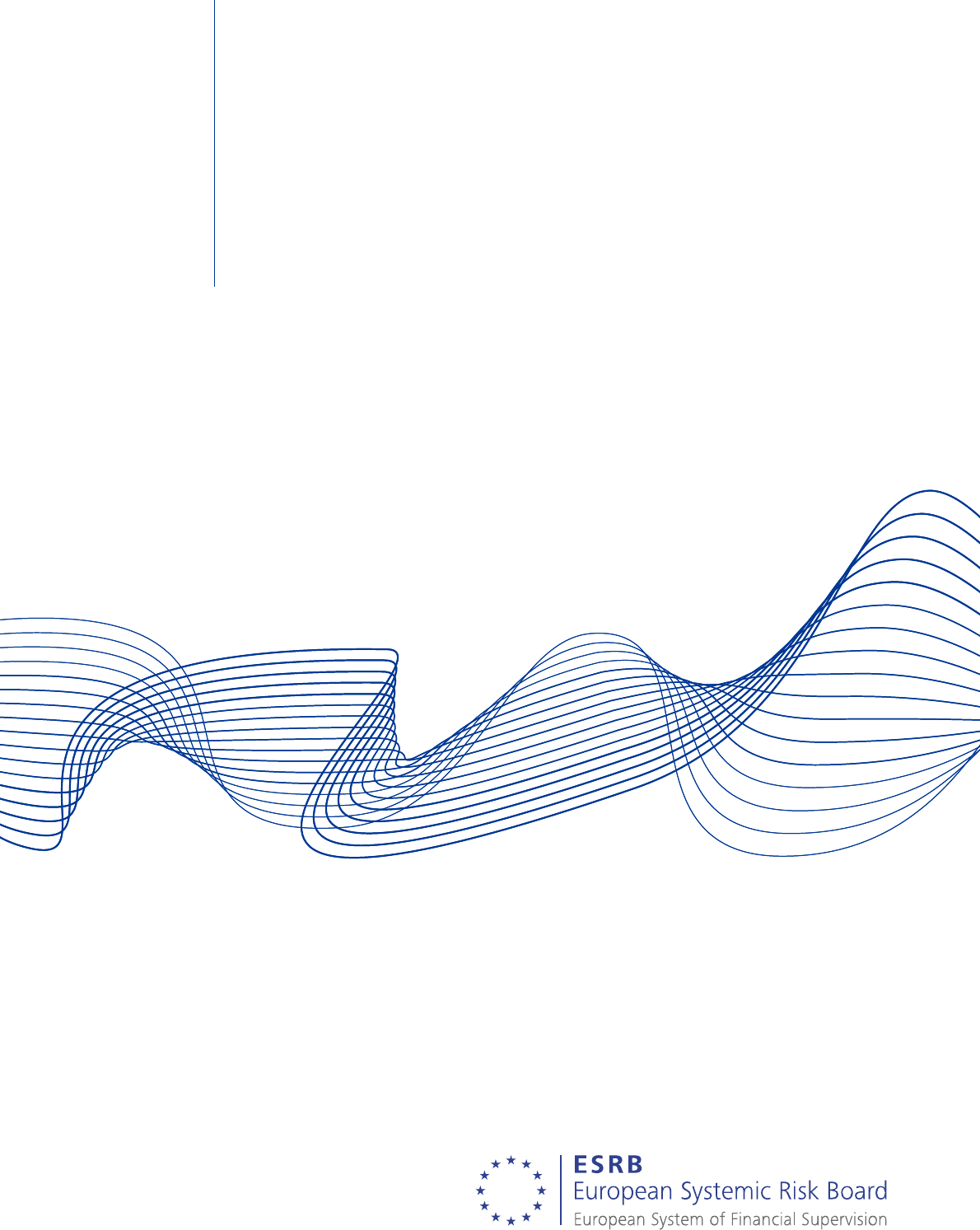
Liquidity risks arising
from margin calls
June 2020

Liquidity risks arising from margin calls / June 2020
Executive summary
2
Central clearing and margin requirements in the bilateral sphere bring high benefits to financial
stability and more particularly in terms of management of counterparty credit risk. Greater central
clearing of derivatives and collateralisation of non-centrally cleared derivatives positions have
significantly strengthened the resilience of derivatives markets since the aftermath of the 2008
financial crisis. These reforms – led by the G20/Financial Stability Board – helped to ensure that
recent market stress has not resulted in widespread concern about counterparty credit risk. Central
clearing also maximises netting opportunities that achieve greater capital and collateral efficiency,
including in respect of variation margin payments that mechanically reflect movements in market
prices.
The coronavirus crisis and the recent oil market disruption caused a sharp drop in asset prices and
increased volatility, resulting among others in significant margin calls across centrally cleared and
non-centrally cleared markets. This report documents two financial stability-related issues: (i) large
amounts of margins called from mid-February to mid-April, which may further increase due to likely
forthcoming credit rating downgrades and possible further market volatility, as well as (ii) the
adverse impact of such margin calls on both bank and non-bank entities, also in view of market
concentration and interconnectedness.
This report proposes a recommendation addressed to the competent authorities in the area of
central counterparties (CCPs), banks and other relevant market participants, encompassing the
following aspects:
1. To the extent compatible with the overarching objective of avoiding jeopardizing the resilience
of counterparties, limit sudden and significant (hence procyclical) changes and cliff effects in
initial margins (including margin add-ons) and in collateral practices: (i) by CCPs vis-à-vis
members; and (ii) by clearing members vis-à-vis their clients; as well as (iii) in the bilateral
market, resulting from the mechanistic use of external credit ratings and possibly procyclical
internal credit scoring methodologies.
2. Include in CCPs liquidity stress testing any two defaulting entities regardless of their role vis-à-
vis the CCP, including liquidity providers to the CCP, to enhance the liquidity resilience of
CCPs by taking into account risks from the systemic, macroprudential perspective related to
the high degree of interconnectedness among CCPs and their liquidity service providers. The
policy also proposes to consider conducting coordinated liquidity stress tests at the EU and/or
global level.
3. To the extent compatible with CCPs’ operational and financial resilience, limit unnecessary
liquidity constraints for clearing members and clients related to operational processes for
margin collection.
4. Steer discussions at international level, through the participation of relevant competent
authorities in international fora and standard setting bodies, where applicable, on means to
mitigate the procyclicality in margin and haircut practices when providing client clearing
services. These discussions should pursue the feasibility assessment, as well as the design
Executive summary

Liquidity risks arising from margin calls / June 2020
Executive summary
3
and set up of global standards governing minimum requirements for risk management when
providing client clearing services – both centrally cleared and non-centrally cleared.
The report also proposes further policies to be considered and analyses to be carried out over the
short to medium term within the ESRB’s structures. Notably, the ESRB could:
1. Recommend to the European Commission to consider the possibility of amending Level 1 or
Level 2 regulation in order to require CCPs to implement an accelerated pass-through of
intraday variation margins, whenever operationally possible and wherever the risk
management framework would not be negatively impacted.
2. Independently assess the antiprocyclicality performance of the International Swaps and
Derivatives Association (ISDA) SIMM model
1
used widely for calibrating margin exchanges in
bilateral derivatives transactions.
3. Analyse the structure of the clearing market in Europe from a financial stability perspective
and its resilience in times of stress, focusing on interconnectedness and concentration in the
provision of clearing services by CCPs and clearing members (also in view of increased
market activity). If needed, recommend adjustments to prudential requirements for managing
concentration risk at the CCP and clearing member level. In this regard, due consideration
should be given to the existing global standards developed by the Basel Committee on
Banking Supervision (BCBS), the committee of Payments and market infrastructures (CPMI)
and the International Organization of Securities Commissions (IOSCO) in order to ensure a
regulatory level playing field with other major jurisdictions.
4. Promote the continued sharing of relevant information by authorities, within their mandate and
respecting confidentiality, and jointly develop analytical tools to enhance the ESRB analytical
toolkit.
Finally, this report conveys the message that CCPs limit dividend payments to shareholders and
earnings distributions to parent companies, or take equivalent action to build up their own funds.
This would help ensure that CCPs maintain adequate prefunded own resources, in addition to initial
margins and default funds, not least in view of increased operational risks.
1
The ISDA Standard Initial Margin Model (SIMM) is an industry-led standardised methodology for calculating initial margin
requirements for non-centrally cleared OTC derivatives.

Liquidity risks arising from margin calls / June 2020
Key issues identified
4
Central clearing and margin requirements in the bilateral sphere bring high benefits to
financial stability and more particularly in terms of management of counterparty credit risk.
Greater central clearing of derivatives and collateralisation of non-centrally cleared derivatives
positions have significantly strengthened the resilience of derivatives markets since the aftermath of
the 2008 financial crisis. These reforms – led by the G20/Financial Stability Board – helped to
ensure that recent market stress has not resulted in widespread concern about counterparty credit
risk. Central clearing also maximises netting opportunities that achieve greater capital and collateral
efficiency, including in respect of variation margin payments that mechanically reflect movements in
market prices.
This report considers the implications of significant margin calls from cash and derivative
positions across the financial system. As the COVID-19 and oil market crisis caused a sharp
drop in asset prices and high levels of market volatility, these developments also resulted in a
significant increase in margin calls from cash and derivative positions.
2
Going forward, these could
have major implications for the liquidity management and funding needs of counterparties, and
possibly even their solvency in a scenario where liquidity stress leads to systematic fire sales of
assets. This report considers the implications for the financial system, in particular focusing on
financial stability risks that could emerge from large margin calls and how these risks could be
mitigated. The report acknowledges that central clearing and margin requirements in the bilateral
sphere bring high benefits to financial stability and that policy action on margins must not
jeopardise protection against counterparty credit risk. Derivatives counterparties, including CCP
clearing members and their clients, should ensure they maintain sufficient liquidity to meet margin
calls in timely fashion. It is though also beneficial, from a financial stability perspective, to ensure
that CCPs’ risk management decisions do not overburden clearing members, their clients and
counterparties because of excessively procyclical features, thus creating unwelcome liquidity
strains, possibly developing into solvency issues.
Recent episodes of high market volatility have led to a substantial increase in margins.
Margin increases have taken place through several channels embedded in the risk management
framework of CCPs (serving the derivative and cash markets) and bilateral OTC derivatives:
(i) initial margin (collateral covering potential future portfolio losses originating from the default of
the counterparty); (ii) variation margin (payments to settle the mark-to-market moves on open
positions); and (iii) intraday margin calls (which cover both mark-to-market moves and the
recalibration of initial margins on account of heightened volatility, leading to greater potential future
losses). In particular, from mid-February to mid-April, initial margins have increased in the wake of
higher transaction volumes, but also because of the response of margin models to higher potential
future losses due to higher market volatility and tail risks.
3
For example, for the cleared segment of
derivative transactions, the total initial margin posted by EU clearing members at the four largest
2
Data in this report rely on EMIR data and thus relate to derivatives transactions. However, anecdotal evidence shows that
FX swap and cash market segments, such as equities, have behaved in a similar fashion.
3
For further details on margining types and factors behind recent margin increases, see item B.1 in Annex B.
1 Key issues identified
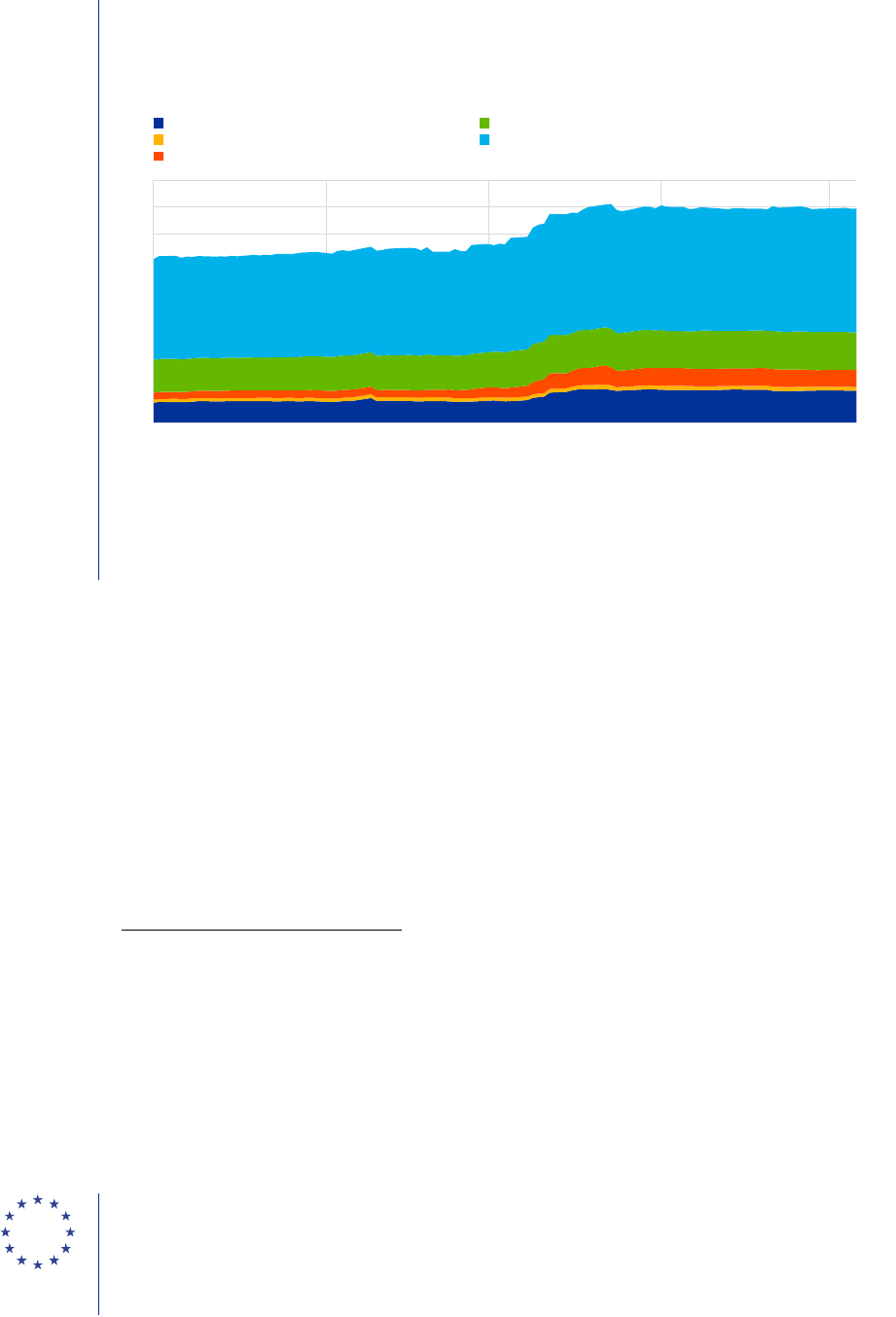
Liquidity risks arising from margin calls / June 2020
Key issues identified
5
CCPs in the EU and in the United Kingdom had increased by ca. €34 billion by the end of March,
4
i.e. by more than one-third of the pre-crisis level (see Chart 1, as well as Charts A.1 and A.2 in
Annex A). Margins are fundamental to how a CCP manages counterparty credit risk and are an
integral part of the risk management of counterparties and support systemic resilience.
Chart 1
Initial margins posted in EU and UK CCPs by area of the CCP and the clearing member
(EUR billions)
Sources: European Systemic Risk Board trade repository data
5
and ESRB Secretariat calculations based on joint work with the
ECB.
Note: The chart includes data for the largest four CCPs (in terms of initial margins) in the EU and the United Kingdom vis-à-vis
their respective clearing members. The latest observation is for 7 May 2020.
Since the outbreak of the COVID-19 pandemic, CCPs have called large amounts of intraday
margin to cover market movements, with the corresponding variation margin payout often
occurring only the next morning, causing liquidity to be temporarily trapped on the accounts
of the CCPs. As highlighted by the ESRB
6
, in some markets CCPs call and collect intraday
margins to cover market movements from loss-making positions together with margin to cover
potential exposures on existing and newly novated positions. As a result, while clearing members
with loss-making positions provide margin to the CCPs to cover this exposure, clearing members
with profit-making positions do not receive the corresponding variation margin payout until the next
day, resulting in the liquidity being held at CCPs overnight during times when it could be most
needed in other areas of the system. During recent weeks, the total amounts of variation margins
have increased substantially (see Chart 2). For one country, the trading data have been cross-
checked with supervisory data on the CCP’s intraday margin calls, which showed that intraday
4
Overall, in the cleared segment of derivatives transactions, initial margins at the four largest CCPs in the EU and in the
United Kingdom increased from ca. €300 billion to ca. €400 billion between January 2020 and end-March 2020. This refers
to the total across all clearing members at any of the four CCPs, including legal entities outside the EU. Of this, €34 billion
was called from EU clearing members, with a surge of €28 billion (80%) in March alone.
5
Trade repository data (or EMIR data) refers to the data accessed by the European Systemic Risk Board based on the
European Market Infrastructure Regulation (EMIR).
6
European Systemic Risk Board (2020b), Mitigating the procyclicality of margins and haircuts in derivatives markets
and securities financing transactions, January 2020.
0
50
100
150
200
250
300
350
400
450
01/20 02/20 03/20 04/20 05/20
EU CCPs – EU clearing members
EU CCPs – Rest of the world clearing members
EU CCPs – UK clearing members
UK CCPs – EU clearing members
UK CCPs – non-EU clearing members
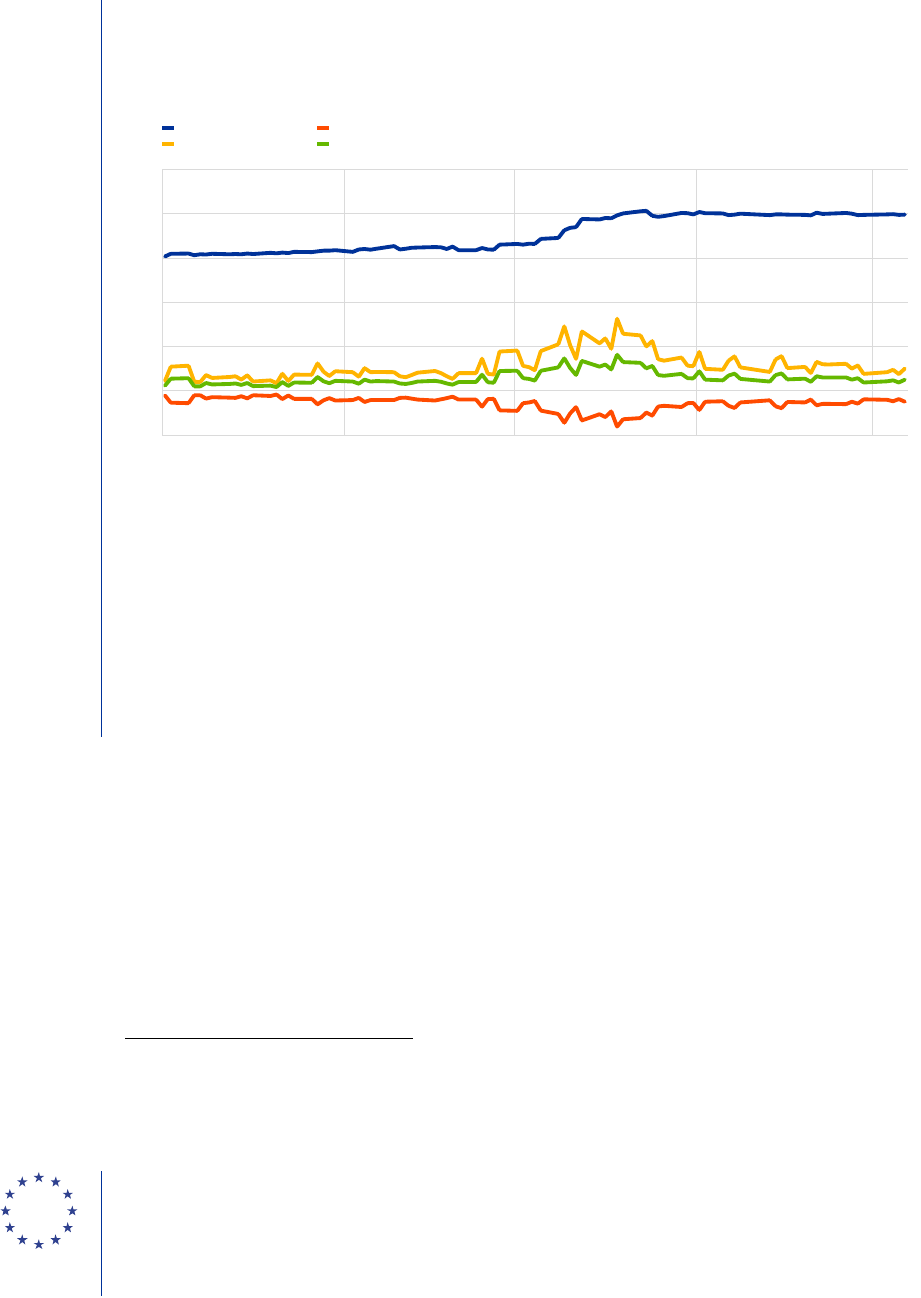
Liquidity risks arising from margin calls / June 2020
Key issues identified
6
margin calls mainly resulted from market movements (i.e. variation margins) on days of high
volatility, and that variation margin gains were not paid out intraday but on the following morning.
Currently intraday margin calls are not passed on in many CCPs for several reasons, e.g. because
these calls cover both mark-to-market changes and top-ups for initial margins on an intraday basis,
or because some CCPs accept non-cash collateral for meeting intraday margin calls, which would
make it challenging to pass on the same day.
Chart 2
Initial and variation margins posted in four EU and UK CCPs
(EUR billions)
Sources: European Systemic Risk Board EMIR data. ESRB Secretariat calculations based on joint work with the ECB.
Note: The chart includes data for the largest four CCPs (in terms of initial margins) in the EU and United Kingdom vis-à-vis their
respective clearing members. The latest observation is for 7 May 2020. The chart shows a comparison of initial and variation
margins posted and received at the four largest CCPs in the EU and the United Kingdom by initial margins (clearing members
from all jurisdictions are included in the aggregates). Gross flows proxies the total amount of liquidity flowing from clearing
members to the CCPs plus the amount from the CCPs to the clearing members until the end of the day. Variation margin
received by the CCPs proxies the amount of clearing members’ cash liquidity needs. Variation margin posted by the CCPs
proxies the amount of cash liquidity received by clearing members. The share of variation margin posted by the CCPs resulting
from intraday margin calls reflects the liquidity subject to a delayed pass-through for some CCPs. The results for each CCP
have been validated with national sources. The methodology has been developed in cooperation with the Deutsche
Bundesbank.
Margin frameworks have responded broadly as expected so far, reflecting the smooth
functioning of cleared and bilateral markets and timely payouts by market participants.
7
Market participants have met margin calls in centrally cleared markets with only minor operational
delays in some cases, which they promptly solved without putting counterparties at risk. In the
bilateral market, the number of disputes has markedly increased, but total amounts have remained
stable. Clearing members have also continued to post high levels of excess collateral at CCPs,
which could be interpreted as a precaution against future margin calls or, possibly, as a sign that
market participants have not so far faced widespread difficulties in sourcing collateral.
7
See also some evidence on the functioning of the repo market in item B.2 in Annex B.
-100
0
100
200
300
400
500
01/20 02/20 03/20 04/20 05/20
Initial margins
Gross flow
Variation margin posted
Variation margin received

Liquidity risks arising from margin calls / June 2020
Key issues identified
7
Some banking entities have seen a particularly marked increase in initial margins and may
have experienced increased liquidity constraints (see Chart 3 and Table A.4 in Annex A), in
terms of cash and collateral available. Such strains could be problematic, should the situation
materially worsen, in view of the high concentration and interconnectedness of the derivatives
markets among several large clearing members.
8
However, capital and liquidity requirements are
relatively favourable for derivative positions (see also Table A.5 in Annex A) and major banks under
the Single Supervisory Mechanism (SSM) have entered this crisis with robust capital and liquidity
positions. In addition, authorities have introduced substantial policy support measures to alleviate
potential liquidity and solvency strains and have incentivised banks to make prompt use of their
buffers. Overall, so far major European clearing members have not reported any significant delays
in meeting margin calls. Currently, major euro area clearing members exceed regulatory liquidity
requirements, and they now also have access to additional liquidity support (e.g. through the
temporary easing of the ECB’s collateral requirements), so that they can be expected to have
sufficient balance sheet space to support client needs if necessary.
Margin calls have likely affected non-bank entities significantly, in bilateral markets or via
client clearing, due to liquidity constraints.
9
According to recent ECB analysis
10
, the daily
variation margin calls on euro area investment funds’ derivative exposures quintupled. For a
substantial share of funds with derivative exposures, the variation margin call exceeded their pre-
crisis cash positions on at least one day during the turmoil. In addition, 6% of funds did not have a
sufficiently large pre-stress liquidity position to cover the cumulative increase in variation margin
during the market turmoil.
11
Furthermore, increases in initial margins posted at CCPs during March
2020 stemmed mainly from client portfolios and to a somewhat lesser extent from house portfolios
(due to comparatively limited house business).
12
Such developments may be of concern given that
most non-banks rely on the services of only one client clearing provider
13
and do not have back-up
arrangements in place. Therefore, clearing providers typically have extensive discretion to change
clearing conditions for their clients in a short period of time, including changes in initial margin
calibrations as well as collateral eligibility. As discussed by the ESRB
14
, current client clearing
arrangements leave clearing members substantial leeway for counterparty-specific add-ons on
initial margins (of up to 50%). While clearing service providers’ collateral requirements are typically
aligned with those of CCPs, clearing providers’ repo desks typically offer (but are not contractually
8
See also the evidence on interconnectedness and concentration in Figures A.1 and A.2 and Tables A.1-A.3 in Annex A.
9
For a more detailed discussion and further evidence on the concentration of client clearing, the impact on non-bank
financial entities and non-financial corporations, as well as on the functioning of the bilaterally cleared FX market, see items
B.3-B.5 in Annex B.
10
See Charts A.3-A.5 in Annex A and Fache Rousová, L., Gravanis, M., Jukonis, A. and Letizia, E. (2020), “Derivatives-
related liquidity risk facing investment funds”, European Central Bank Financial Stability Review, Special Feature B,
May 2020.
11
For further evidence of possible liquidity constraints in non-bank financial entities, see de Jong, A., Draghiciu, A., Fache
Rousová, L., Fontana, A. and Letitia, E. (2019), Impact of variation margining on insurers' liquidity: An analysis of
interest rate swap positions, EIOPA, 2019, as well as Danmarks Nationalbank (2019), “Pension companies will have
large liquidity needs if interest rates rise”, November 2019.
12
See evidence in Chart A.2 in Annex A. House portfolios mean clearing members’ own portfolios, as opposed to the
portfolios of clearing members’ clients.
13
See also evidence in Table A.3 and Figure A.2 in Annex A.
14
European Systemic Risk Board (2020b), Mitigating the procyclicality of margins and haircuts in derivatives markets
and securities financing transactions, January 2020.

Liquidity risks arising from margin calls / June 2020
Key issues identified
8
obliged to provide) collateral transformation services to their clients, which increases client
dependency on the clearing provider.
Going forward, the ability of market participants to meet margin calls will depend on future
levels of volatility and the ongoing resilience of their liquidity management (although
solvency risks cannot be excluded). Other important potential channels of liquidity strains
include measures taken by CCPs to mitigate credit risk stemming from collateral issuers or clearing
members.
15
So far, there is only anecdotal evidence that some CCPs have taken action in this
regard. However, CCPs’ risk management practices may still reflect downgrades by credit rating
agencies (either of collateral issuers or of counterparties), which are also likely to materialise in the
future weeks and months. Any downgrade-related changes which are directly reflected in the
collateral or counterparty policies might imply that counterparties need to post or substitute large
amounts of collateral at short notice (e.g. where a measure affects domestic government bonds
which are frequently used as collateral), or even result in them being excluded from both clearing
facilities and the bilateral segment of the market. Overall, concentration at CCPs and clearing
members and interconnectedness among CCPs through common clearing members, liquidity
providers, custodians or investment counterparts may also lead to further cascade effects.
15
For further background, see items B.6-B.7 in Annex B.
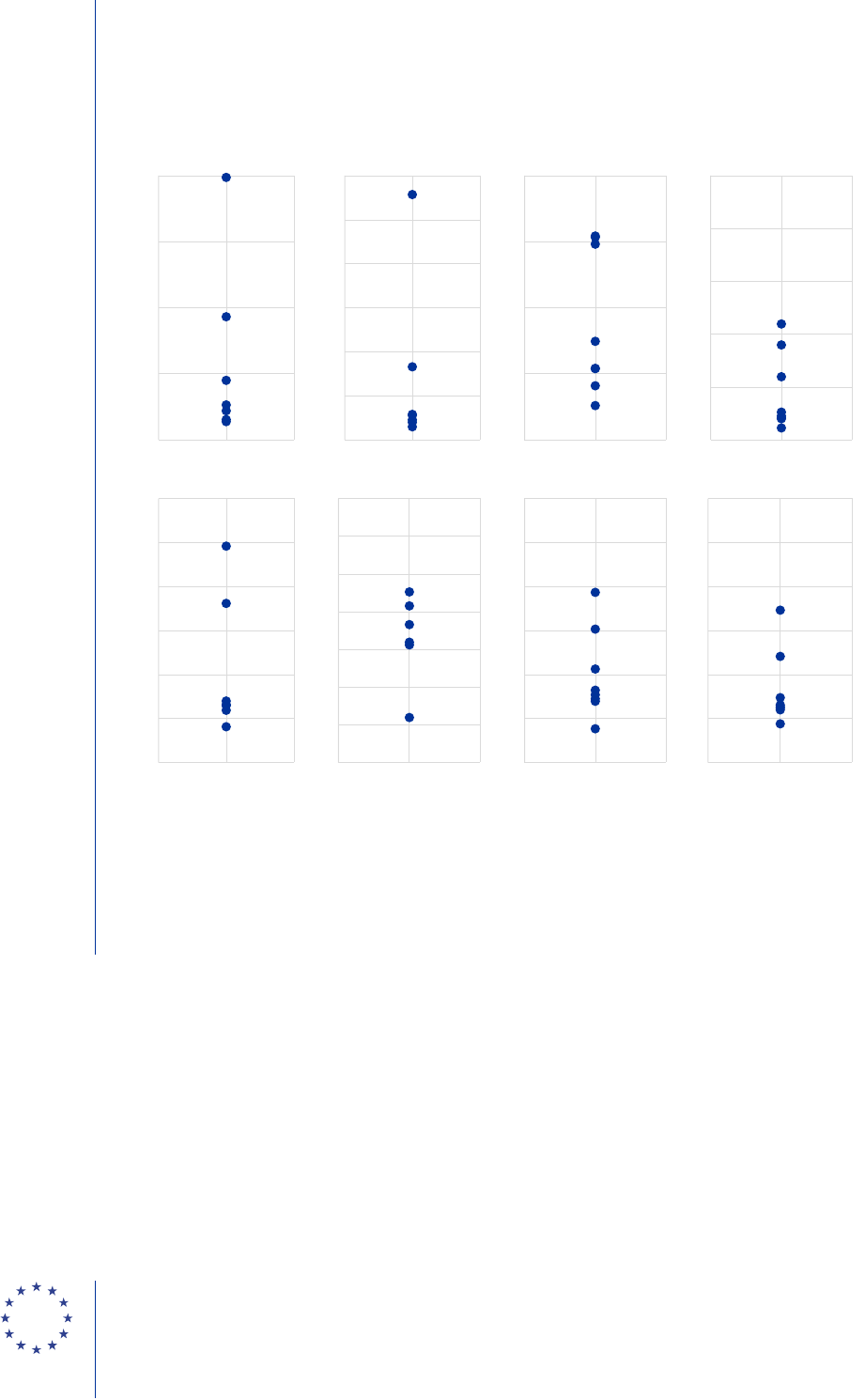
Liquidity risks arising from margin calls / June 2020
Key issues identified
9
Chart 3
Initial margins (IM) posted as at the end of March and called during Q1 2020 for several
European banks relative to their capital, cash holdings, debt securities holdings and total
assets
Sources: European Systemic Risk Board EMIR data, SNL and the ESRB Secretariat’s calculations.
Notes: The charts present the amount of initial margin outstanding at EU and UK CCPs for several European banks with
relatively high initial margins at the end of March 2020 (upper panel) and initial margin called in Q1 2020, as a ratio of CET1
(SNL Table 220292), cash holdings of these banks, defined as cash and balances with central banks (SNL Table 246025), debt
securities holdings (SNL Table 224927) and total assets (SNL Table 132264) as at the end of 2019. Banks are presented on an
anonymised basis for confidentiality reasons. For one bank, the values of margin called relative to cash (ca. 62%) are not shown
in the scatter plot for presentational reasons.
0%
50%
100%
150%
200%
IM outstanding to
capital
0%
20%
40%
60%
80%
100%
120%
IM outstanding to
cash
0%
5%
10%
15%
20%
IM outstanding to total
debt instruments
0%
2%
4%
6%
8%
10%
IM outstanding to total
assets
-20%
0%
20%
40%
60%
80%
100%
IM called to capital
-4%
-2%
0%
2%
4%
6%
8%
10%
IM called to cash
-3%
0%
3%
6%
9%
12%
15%
IM called to total debt
instruments
-1%
0%
1%
2%
3%
4%
5%
IM called to total
assets

Liquidity risks arising from margin calls / June 2020
Policies to mitigate risks to financial stability
10
In view of the identified financial stability risks that could emerge from large margin calls,
the report proposes that the European Systemic Risk Board should immediately advocate
four policies which could be implemented through one recommendation to the relevant
Competent Authorities (in the areas of CCPs’, banking and other financial market
participants). To the extent possible, EU authorities should also promote these policies in
international fora, as they may affect EU market participants active in other jurisdictions and
to promote a level playing field across the clearing network at global level.
Policy 1. To the extent compatible with the financial resilience of counterparties, limit
sudden and significant (hence procyclical) changes and cliff effects in initial margins
(including margin add-ons) and in collateral framework: (i) by CCPs vis à vis members; and
(ii) by clearing members vis-à-vis their clients; as well as (iii) in the bilateral market,
resulting notably from the mechanistic use of external credit ratings and possibly
procyclical internal credit scoring methodologies.
The ESRB recommends that national competent authorities (NCAs) of the CCPs:
1. ensure that CCPs’ issuer and counterparty credit risk management frameworks (a) use
progressive and granular steps, in particular when implementing ratings downgrades, without
unduly delaying the feeding of these downgrades in their overall risk management practices
and (b) limit procyclical features in internal models, including by considering appropriate
margins of conservatism;
2. inform authorities represented in the respective EMIR College, when (and to the extent it does
not interfere with the timely implementation of risk management decisions, before) CCPs
implement a reduction in the scope of eligible collateral, or any material increase in collateral
“haircuts”, or any decrease in the concentration limits on the amount of collateral accepted
from a single issuer;
3. engage with CCPs (and possibly intermediaries for non-centrally cleared trades) to thoroughly
analyse the antiprocyclicality performance of the tools they have used during the most acute
periods of stress, and report on these analyses to their supervisory authorities.
Purpose: Limiting sudden and significant (hence procyclical) changes and cliff effects both in the
initial margin framework (including margin add-ons) and collateral framework would aim at reducing
sharp increases in initial margin requirements and consequently collateral demand. This in turn
would alleviate funding pressures for clearing members and clients.
When considering margin
increases by CCPs, EMIR already addresses the need to maintain antiprocyclicality tools in order
to limit procyclicality. Nevertheless, management of (issuer and counterparty) credit risk can also
have harmful procyclical effects and lead to liquidity strains. These result from: (i) the use of credit
rating agency (CRA) ratings, as downgrades can lead to automatic procyclicality; (ii) internal CCP
haircut models and credit scoring methodologies. This is not addressed by EMIR. Concerning the
initial margins applied by clearing members to their clients, the current market practice, especially
2 Policies to mitigate risks to financial
stability

Liquidity risks arising from margin calls / June 2020
Policies to mitigate risks to financial stability
11
in equity and listed derivative clearing, is that clearing members increase collateral requirements
and collateral haircuts vis-à-vis their clients more than proportionally (by a multiple of more than
one) compared with what the CCP actually requires of them for their clients positions. This
conservative approach might vary according to: (i) the type of counterparty; as well as (ii) the credit
quality of counterparts. This might amplify liquidity drains for CCP end-users. Currently, there is no
provision in international standards setting minimum requirements regarding the risk management
practices between clearing members and their clients. Therefore there is no provision in the EU
framework in this regard, nor does the framework require clearing members to enforce
antiprocyclical margin management practices. While the amendments known as the “EMIR Refit”
enhance the transparency around margin setting between CCPs and clearing members, the same
transparency does not yet extend sufficiently to the relationship between clearing members and
their clients, in the absence of an international standard in this regard. Counterparties and in
particular CCPs should apply this recommendation in a way which is compatible with their ongoing
financial resilience.
Policy 2. Include in CCPs liquidity stress testing any two defaulting entities regardless of
their role vis-à-vis a CCP, including liquidity providers to the CCP, to enhance the liquidity
resilience of CCPs by taking into account risks from the systemic and macroprudential
perspective related to the high degree of interconnectedness among CCPs and their
liquidity service providers. The policy also proposes to consider conducting coordinated
liquidity stress tests at the EU or global level.
The ESRB recommends that the European Securities and Markets Authority (ESMA) review its
draft technical standards under Article 44(2) of Regulation (EU) No 648/2012 so that CCPs include
in their liquidity stress test the default of any two entities providing services to a CCP that could
affect its liquidity situation. Currently they limit their framework to the default of any two clearing
members, as put forward by ESMA in the liquidity stress testing exercise in 2019. For example, the
default of any entity acting as an investment and repo counterparty, payment agent, custodian or
liquidity provider should be envisaged when selecting the two defaulting entities with the largest
impact on the liquidity position of the CCP, even if they are not a clearing member. Any existing
back-up arrangement would be taken into account. This will improve the overall market resilience,
in view of a large degree of concentration and interconnection among CCPs and their liquidity
service providers and, consequently, the fact that prudent liquidity management at individual CCP
level might not necessarily cover the risks from the systemic, macroprudential, perspective.
Pending the action taken by ESMA to comply with the above mentioned recommendation and the
possible introduction of corresponding EU legislation, it is recommended that competent authorities
ensure that the stress scenarios under Article 44 of Regulation (EU) No 648/2012 include the
default of any two entities that provide services to the CCP and whose default could materially
affect the liquidity position of the CCP. NCAs should encourage CCPs to react to any identified
weakness as a result of this enhanced stress test in a way that does not create additional burdens
on its members. For example, this could mean encouraging a CCP to find additional liquid
resources, but not imposing further limits on the collateral eligibility.
Considering the large concentration in the provision of liquidity services, as well as global
interconnections between CCPs and liquidity service providers, competent authorities should
engage with CCPs – and to the extent possible with other relevant authorities in third countries – to

Liquidity risks arising from margin calls / June 2020
Policies to mitigate risks to financial stability
12
conduct coordinated liquidity stress test exercises. These should include the default of any two
entities that provide liquidity services to CCPs and whose default could materially affect the liquidity
positions of CCPs. This coordinated exercise could take place at the EU level or at a global level.
Purpose: In their liquidity stress testing CCPs should capture comprehensively all the events that
may cause them to face a liquidity shortfall.
16
This would incentivise CCPs to mitigate their reliance
on a liquidity provider. Since there is a significant degree of concentration in the provision of
liquidity and payment services to CCPs, this would enhance overall stability at market infrastructure
level. The conduct of coordinated liquidity stress test exercises globally or at the EU level could
also increase resilience in the liquidity risk management frameworks of CCPs in the EU.
Policy 3. To the extent compatible with CCPs’ operational and financial resilience, limit
unnecessary liquidity constraints for clearing members and clients related to operational
processes for margin collection
The ESRB recommends that NCAs encourage CCPs to the extent legally possible to ensure that
their operational (either variation or initial) margining frameworks (including schedules) do not lead
to unsurmountable operational liquidity constraints that may crystallise in default events. This could
in particular be achieved by:
1. Where operationally possible and to the extent that it does not materially affect the capacity of
the member to use it for the novation of new transactions, CCPs should consider the
possibility of offsetting excess collateral against intraday margin calls.
2. Where operationally and legally possible, provided that the risk management framework is not
negatively impacted and the capacity of the CCPs to manage their intraday margins and
settlements flows is not materially affected, CCPs should identify separately:
(a) intraday margins covering potential exposures, including exposures due to positions
entered into and novated on that day;
(b) intraday margins covering realised exposures due to market movements on that day,
which CCPs should consider paying out to clearing members whose positions have
positive mark-to-market values as soon as possible, and possibly on the same
settlement day.
Purpose: To the extent operationally and legally feasible, and compatible with their risk
management frameworks, CCPs should seek to ensure that their operational processes for the
collection of margins are predictable, transparent and limit liquidity strains in the financial system.
Limiting the liquidity trapped in CCPs would involve encouraging CCPs to the extent legally
possible to limit the asymmetry embedded in the current operational clearing framework. Currently,
most CCPs call intraday margins covering both potential future exposures and negative mark-to-
market adjustments, and positive mark-to-market adjustments are passed to members only at the
end of the day or even the next day. This CCP practice could give rise to cash constraints for
clearing members, as well as potential liquidity drains for their clients. However, CCPs would need
16
This builds up on an Opinion published by ESMA.

Liquidity risks arising from margin calls / June 2020
Policies to mitigate risks to financial stability
13
to consider the suitability of this policy for their operational processes, accounting processes and
risk management framework and the impact on their clearing members. In some markets, intraday
prices are not fully transparent and intraday margin calls are based on proxies and collected in non-
cash.
Policy 4. Recommend to competent authorities to engage in discussions at international
level, through their participation in international fora and standard setters bodies, on means
to mitigate the procyclicality in margin and haircut practices when providing client clearing
services. These discussions should pursue the feasibility assessment, as well as the design
and set up of global standards governing minimum requirements for risk management when
providing client clearing services – both centrally cleared and non-centrally cleared.
Purpose: The legal framework governing the provision of clearing services in relation to all
derivative and cash contracts and for non-cleared repo contracts should aim at explicitly mitigating
the procyclicality in margin and “haircut” practices. This would aim at making liquidity planning as
predictable and manageable as possible by reducing unexpected and significant cash calls, and
providing reasonable and enforceable notice periods for any changes in the initial margin and
haircut protocols to ensure that markets participants can adapt smoothly. Discussions should be
engaged in the relevant standard setting bodies in order to consider the design and set up of global
standards in this regard. This should be pursuant to already existing provisions in regulatory
technical standards for risk-mitigation techniques for OTC derivative contracts not cleared by a
central counterparty.
The report also proposes further policies to be considered and analyses to be carried out
over the short to medium term within the ESRB’s structures. Notably, the ESRB could:
1. Recommend that the European Commission considers the possibility of amending Level 1 or
Level 2 regulation in order to require CCPs to implement pass-through of intraday variation
margins, whenever operationally and legally possible and, provided that the risk management
framework is not negatively impacted, and to the extent it does not materially affect the
financial resilience of the CCPs.
2. Independently assess the antiprocyclicality performance of the ISDA SIMM model used widely
for calibrating margin exchanges in bilateral derivatives transactions.
3. Analyse the structure of the clearing market in Europe from a financial stability perspective
and its resilience in times of stress, focusing on interconnectedness and concentration in the
provision of clearing services by CCPs and clearing members (also in view of increased
market activity).If needed recommend adjustments to prudential requirements for managing
concentration risk at the CCP and clearing member level. In this regard, due consideration
should be given to the existing global standards developed by the Basel Committee on
Banking Supervision (BCBS) and the International Organization of Securities Commissions
(IOSCO) in order to ensure a regulatory level playing field with other major jurisdictions.
4. Promote the continued sharing of relevant information by authorities, within their mandate and
respecting confidentiality, and jointly develop analytical tools to enhance the ESRB analytical
toolkit.

Liquidity risks arising from margin calls / June 2020
Policies to mitigate risks to financial stability
14
Finally, this report conveys the message that CCPs limit dividend payments to shareholders
and earnings distributions to parent companies, or take equivalent action to build up their
own funds. This would help ensure that CCPs maintain adequate prefunded own resources
in addition to initial margins and default funds, not least in view of operational risks.

Liquidity risks arising from margin calls / June 2020
References
15
Acosta-Smith, J., Ferrara, G. and Rodriguez-Tous, F. (2018), “The impact of the leverage ratio
on client clearing”, Bank of England Staff Working Paper, No 735, 15 June 2018.
Avellaneda, M. and Cont, R. (2013), “Close-Out Risk Evaluation (CORE): A new risk-
management approach for central counterparties”, Finance Concepts.
Bank for International Settlements (2019b), “The Basel Framework: Calculation of RWA for
credit risk”.
Bank for International Settlements (2019c), “The Basel Framework: Leverage ratio”.
Bank for International Settlements (2019d), “The Basel Framework: Liquidity coverage ratio”.
Bank for International Settlements (2019e), “The Basel Framework: Net stable funding ratio”.
Bank of England (2019), “Does the reliance of principal trading firms on banks pose a risk to
UK financial stability?” August 2019.
Bardoscia. M., Bianconi, G. and Ferrara, C. (2019a), “Multiplex network analysis of the UK OTC
derivatives market”, Bank of England Staff Working Paper, No 726, 18 May 2018.
Bardoscia, M., Ferrara, G., Valise, N. and Yoganayagain, M. (2019b), “Simulating liquidity stress
in the derivatives market”, Bank of England Staff Working Paper, No 838, 20 December 2019.
Bartholomew, H. (2020), “After coronavirus rout, concerns raised about Simm”, Risk.net, April
2020.
Cont, R. (2017), “Central clearing and risk transformation”, Norges Bank, March 2017.
Danmarks Nationalbank (2019), “Pension companies will have large liquidity needs if interest
rates rise”, November 2019.
de Jong, A., Draghiciu, A., Fache Rousová, L., Fontana, A. and Letitia, E. (2019), “Impact of
variation margining on insurers' liquidity: An analysis of interest rate swap positions”,
EIOPA, 2019.
Duffie, D. (2018), “Post-crisis bank regulations and financial market liquidity”, Baffi Lecture,
March 2018.
Duffie, D., Scheicher, M. and Vuillemey, G. (2015), “Central clearing and collateral demand”,
Journal of Financial Economics, Vol. 116(2), pp. 237-256.
Glasserman P. and Wu, Q. (2018), “Persistence and procyclicality in margin requirements”,
Management Science, 64(12), pp. 5461-5959.
References

Liquidity risks arising from margin calls / June 2020
References
16
El-Omari, Y., Fiedor, P., Lapschies, S., Schaanning, E., Seidel, M. and Vacirca, F. (2020),
“Interdependencies in central clearing in the EU derivatives market”, European Systemic Risk
Board Occasional Paper, forthcoming.
European Banking Authority (2020), “Interactive single rulebook”, as of April 2020.
European Central Bank (2020), “ECB announces package of temporary collateral easing
measures”, 7 April 2020.
European Central Bank/ Banking Supervision (2020), “Supervisory banking statistics”, Q4 2019.
European Commission (2020), “Economic forecasts”, Spring 2020.
European Securities and Markets Authority (2020), “Report on trends, risks and vulnerabilities”,
No 1. 2020.
European Securities and Markets Authority (2018), “EU-Wide CCP Stress Test 2017”, February
2018.
European Systemic Risk Board (2020a), “Risk dashboard”, March 2020.
European Systemic Risk Board (2020b), “Mitigating the procyclicality of margins and haircuts
in derivatives markets and securities financing transactions”, January 2020.
European Systemic Risk Board (2019), “EU non-bank financial intermediation risk monitor
2019”, July 2019.
European Systemic Risk Board (2017a), “Revision of the European Market Infrastructure
Regulation”, April 2017.
European Systemic Risk Board (2017b), “ESRB report on the macroprudential use of margins
and haircuts”, February 2017.
European Systemic Risk Board (2016a), “Macroprudential policy issues arising from low
interest rates and structural changes in the EU financial system”, November 2016.
European Systemic Risk Board (2016b), “The impact of low interest rates and ongoing
structural changes on financial markets and financial infrastructure: assessment of
vulnerabilities, systemic risks and implications for financial stability”, Technical
Documentation Section D of European Systemic Risk Board (2016a).
European Systemic Risk Board (2016c), “ESRB response to the ESMA Consultation Paper on
the clearing obligation for financial counterparties with a limited volume of activity”,
September 2016.
European Systemic Risk Board (2016d), “ESRB report to the European Commission on the
systemic risk implications of CCP interoperability arrangements”, January 2016.

Liquidity risks arising from margin calls / June 2020
References
17
European Systemic Risk Board (2015a), “ESRB report on the efficiency of margining
requirements to limit pro-cyclicality and the need to define additional intervention capacity
in this area”, July 2015.
European Systemic Risk Board (2015b), “ESRB report on the issues to be considered in the
EMIR revision other than the efficiency of margining requirements”, July 2015.
Fache Rousová, L., Gravanis, M., Jukonis, A. and Letizia, E. (2020), “Derivatives-related liquidity
risk facing investment funds”, European Central Bank Financial Stability Review, Special
Feature B, May 2020.
Financial Stability Board (2018a), “Incentives to centrally clear over-the-counter (OTC)
derivatives, A post-implementation evaluation of the effects of the G20 financial regulatory
reforms – final report”, November 2018.
Financial Stability Board (2018b), “Analysis of central clearing interdependencies”, August
2018.
Financial Stability Board (2017), “Analysis of central clearing interdependencies”, July 2017.
Hoffmann, P., Langfield, S., Pierobon, F. and Vuillemey, G. (2019), “Who bears interest rate
risk?”, Review of Financial Studies, 32(8), pp. 2921-2954.
Huang, W. (2019a), “Central counterparty capitalization and misaligned incentives”, Bank for
International Settlements Working Paper, No 767, 11 February 2019.
Huang, W. and Takáts, E. (2020a), “Model risk at central counterparties: Is skin-in-the-game a
game changer?”, Bank for International Settlements Working Paper, No 866, 25 May 2020.
Huang, W. and Takáts, E. (2020b), “The CCP-bank nexus in the time of Covid-19”, Bank for
International Settlements Bulletin, No 13, 11 May 2020.
International Swaps and Derivatives Association (2019), “Leverage ratio treatment of client
cleared derivatives”, 16 January 2019.
Krahnen, J. P. and Pelizzon, L. (2016), “Predatory Margins and the Regulation and Supervision
of Central Counterparty Clearing Houses (CCPs)”, SAFE White Paper No 41, September 2016.
Lenoci, F. and Letizia, E. (2020), “Classifying the counterparty sector in EMIR data”, European
Central Bank Working Paper, forthcoming.
Regulation (EU) No 575/2013 of the European Parliament and of the Council of 26 June 2013 on
prudential requirements for credit institutions and investment firms and amending Regulation (EU)
No 648/2012 (CRR).
Roberson, M. (2018), “Cleared and uncleared margin comparison for interest rate swaps”,
April 2018.

Liquidity risks arising from margin calls / June 2020
References
18
Rosati, S. and Vacirca, F. (2019), “Interdependencies in the euro area derivatives clearing
network: a multi-layer network approach”, European Central Bank Working Paper, No 2342,
December 2019.
Schrimpf, A., Shin, H. S. and Sushko, V. (2020), “Leverage and margin spirals in fixed income
markets during the Covid-19 crisis”, Bank for International Settlements Bulletin No 2, 2 April
2020.
Temple-West, P. (2020), “Rating agencies brace for backlash after rash of downgrades”,
Financial Times, 3 April 2020.
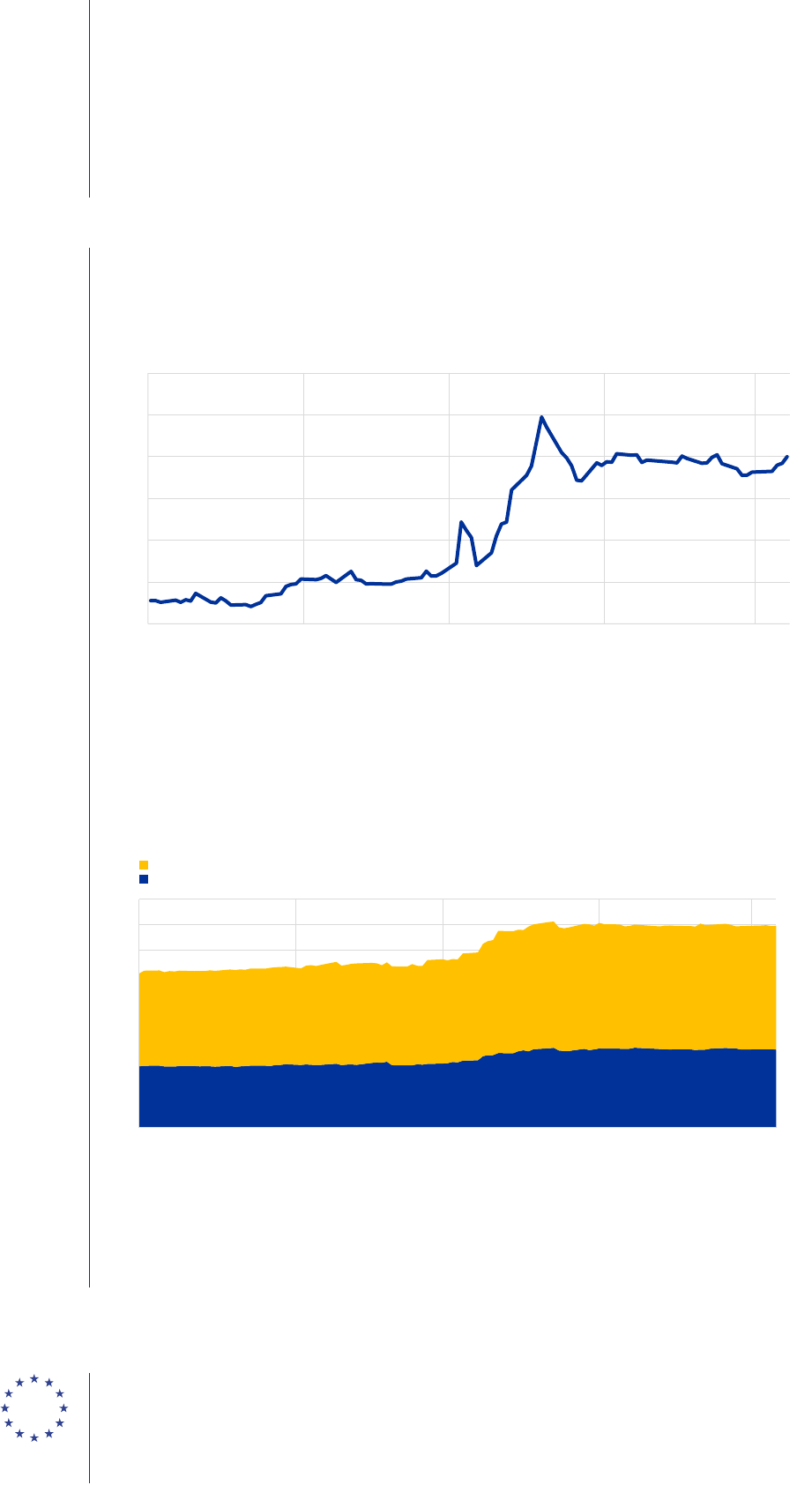
Liquidity risks arising from margin calls / June 2020
Annex A: Background charts
19
Chart A.1
Initial margins posted in European CCPs by German market participants
(19 February 2020 = 100)
Sources: EMIR data and Deutsche Bundesbank calculations.
Notes: The chart presents an equally weighted average of initial margin index (19 February 2020 = 100) across six CCPs, as
based on the initial margins pledged by German market participants to the CCPs. 19 February 2020 represents the date of the
pre-crisis peak for various equity indices (e.g. EURO STOXX 50, DAX, S&P 500) before the coronavirus (COVID-19) crisis. The
latest observation is for 7 May 2020.
Chart A.2
Initial margins posted by house and client accounts
Sources: European Systemic Risk Board EMIR data and ESRB Secretariat calculations based on joint work with ECB.
Note: The chart includes data for the largest four CCPs (in terms of initial margins) in the EU and United Kingdom vis-à-vis their
respective clearing members. The fraction of client initial margins is an upper bound estimate produced by combining CCP data
from the Public Quantitative Disclosure framework for Central Counterparties and (where available) EMIR data. The latest
observation is for 7 May 2020.
80
100
120
140
160
180
200
01/20 02/20 03/20 04/20 05/20
0
50
100
150
200
250
300
350
400
450
01/20 02/20 03/20 04/20 05/20
Client
House
Annex A: Background charts
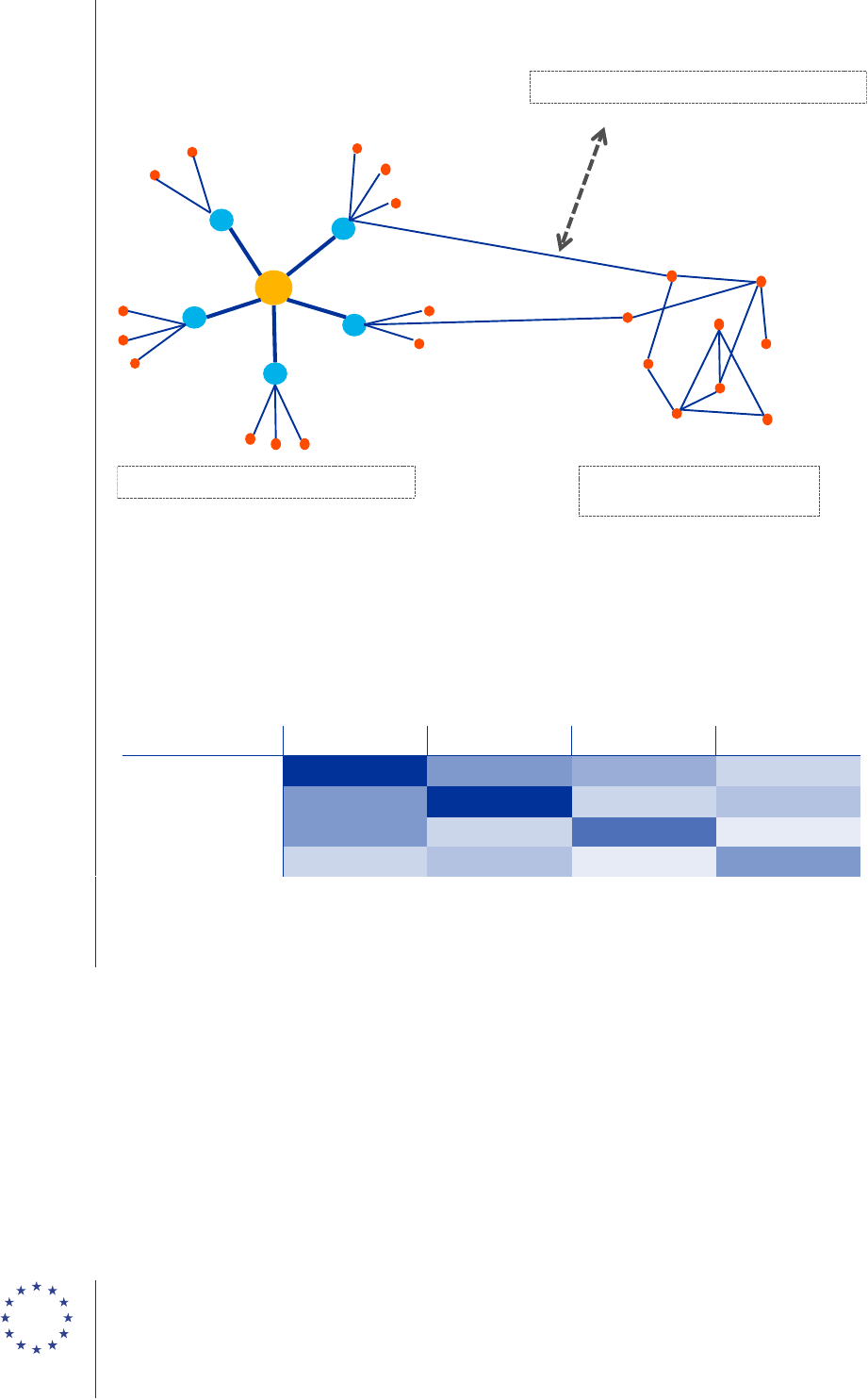
Liquidity risks arising from margin calls / June 2020
Annex A: Background charts
20
Figure A.1
Schematic overview of margining in derivative markets
Source: European Systemic Risk Board.
Note: The chart presents a schematic overview of margining interdependencies in the cleared and bilateral derivatives markets.
Table A.1
Interconnectedness among CCPs: number of common clearing members (CMs) on 30 March
2020
LCH Ltd Eurex Clearing AG ICE Clear Europe LCH SA
LCH Ltd
127 60 57 41
Eurex Clearing AG
60 127 42 45
ICE Clear Europe
57 42 91 35
LCH SA
41 45 35 53
Sources: European Systemic Risk Board EMIR data and ESRB Secretariat calculations based on joint work with the ECB.
Note: Number of CMs in common where the higher the number the darker the shade of blue.
Securities financing transactions
Funding of collateral
Collateral
CCP
CLEARING
MEMBER
CLIENTS
Centrally cleared derivatives
Non-centrally cleared
derivatives

Liquidity risks arising from margin calls / June 2020
Annex A: Background charts
21
Table A.2
Concentration of initial margins posted to EU and UK CCPs on 30 March 2020
Number of CMs Percentage of IM posted
Top 5
20.41%
Top 10
35.03%
Top 15
46.43%
Top 20
55.98%
Top 30
69.95%
Top 50
83.97%
Top 100
96.21%
Sources: European Systemic Risk Board EMIR data and ESRB Secretariat calculations based on joint work with the ECB.
Note: The top four EU and UK CCPs by initial margins are included in the sample, with a total of 230 clearing members.
Table A.3
Number of clearing members active in several asset classes
Interest rates Credit Currency Equity Commodities
Interest rates
189 32 32 92 59
Credit
32 17 25 20
Currency
38 25 21
Equity
708 50
Commodities
245
Sources: European Systemic Risk Board, EMIR data and ESRB Secretariat calculations.
Notes: The table shows the number of clearing members that are simultaneously active in combinations of derivative classes.
Data are as of May 2019. See El-Omari, Y., Fiedor, P., Lapschies, S., Schaanning, E., Seidel, M. and Vacirca, F. (2020),
“Interdependencies in central clearing in the EU derivatives market”, European Systemic Risk Board Occasional Paper,
forthcoming.
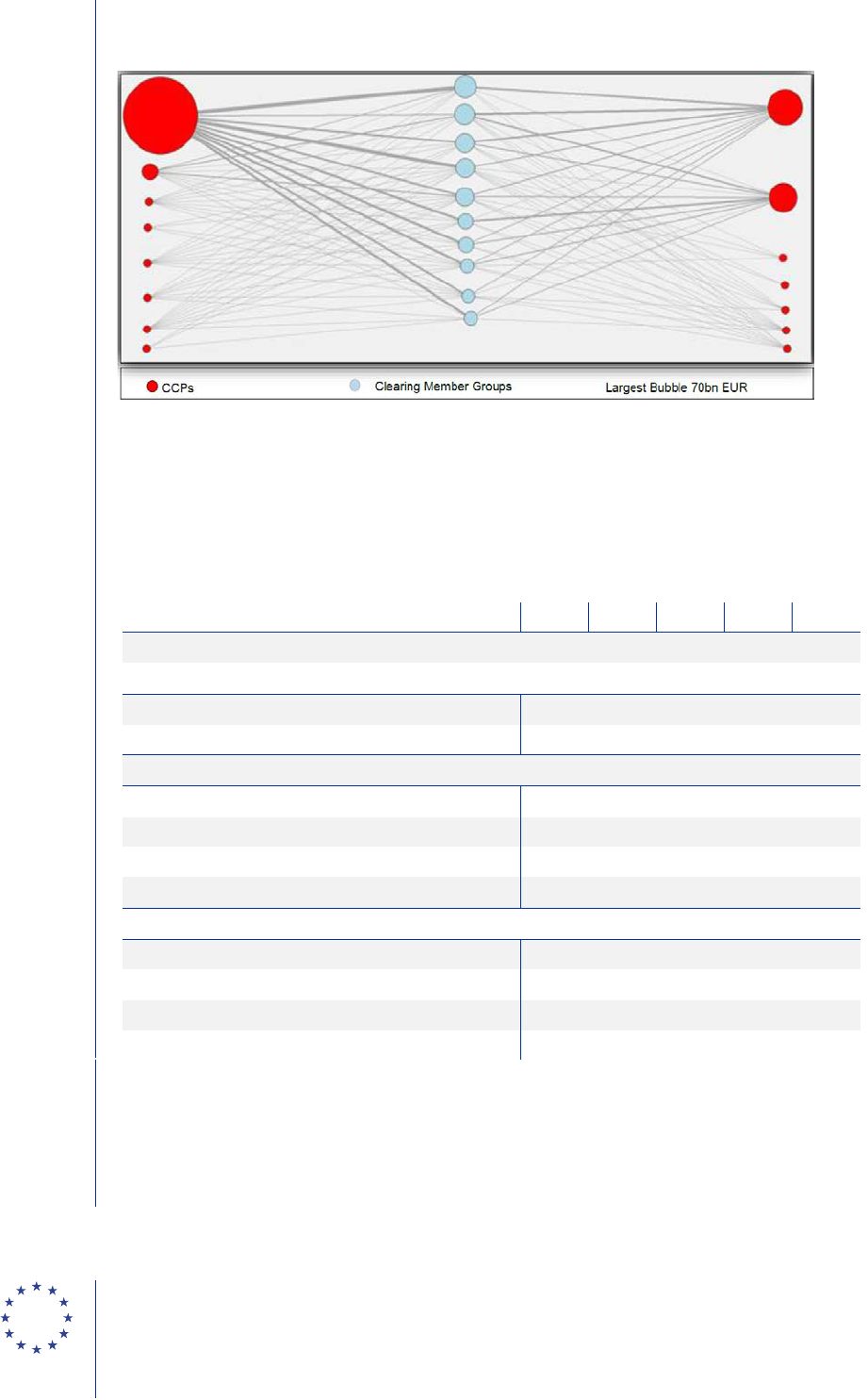
Liquidity risks arising from margin calls / June 2020
Annex A: Background charts
22
Figure A.2
Network of top 10 clearing member groups by default fund contributions and margins
Source: European Securities and Markets Authority (2018), EU-Wide CCP Stress Test 2017, February 2018, Figure 22.
Note: The results of the more recent stress test are currently under production.
Table A.4
Margins posted to CCP and available collateral of euro area (EA) banks
(EUR billions)
EA DE FR IT ES
Initial Margins posted to EU and UK CCPs by
EA clearing member banks
03/01/2020
95.58 38.363 33.792 8.613*
26/03/2020
125.058 55.039 38.934 13.389*
Bank balance sheet items
Cash, cash balances at central banks, other demand deposits
1807.1 402.2 614.4 92.3 215.5
Debt securities
2848.6 510.8 780.5 480.2 448.5
Encumbered assets
4274.6 975.8 1198.8 635.3 694.1
Unencumbered assets
17908.2 2755.9 6265.6 1811 2646.2
Value of derivatives on bank balance sheets
Derivatives – Trading (asset side)
1412.6 470.1 580.6 70.1 120.5
Derivatives – Other (asset side)
139.7 13.1 69.1 9.9 15.4
Derivatives – Trading (liabilities side)
1379.5 447 572.4 70.6 116.1
Derivatives – Other (liabilities side)
202.7 19.8 71.3 20.3 11.7
Sources: SSM supervisory banking statistics, EMIR data, ESRB Secretariat calculations.
Notes: The balance sheet data cover 113 significant euro area banks as at the end of 2019 at the highest level of consolidation.
Not all significant banks are clearing members. Balance sheet values of derivatives are reported, e.g. market values rather than
notional values. * The items on initial margins posted by IT and ES clearing member banks are shown as a sum for both
countries due to trade repository data confidentiality requirements.

Liquidity risks arising from margin calls / June 2020
Annex A: Background charts
23
Table A.5a
Comparison of capital charges for credit risk for banks
Risk-weighted framework for credit risk
Risk weight Basis Legal reference
CCP exposures
Trade exposures to CCP
(margins)
2%*
Small fraction of notional amount
(Current exposure + Potential
future exposure)
CRR Art. 306
Trade exposures of CCP
members to clients
20%-150% (risk weight of the
counterparty)
Small fraction of notional amount
(Current exposure + Potential
future exposure)
CRR Art. 304
Default fund contribution
2% (theoretical limit) –
1250% (worst case scenario)
*****
Nominal amount CRR Art. 307
Other exposures under standardized approach (for comparison)
Central banks and central
governments
0%** Nominal amount CRR Art. 114
Repos (fully collateralized)
0%*** Nominal amount
CRR Art. 222, Art. 223 in
conjunction with
Art. 227CRR
Covered bonds
10-100% Nominal amount CRR Art. 129
Banks and corporates
(unsecured)
20-150% (depending on
credit quality)
Nominal amount CRR Art. 120-123
Residential mortgages
(fully secured)
35% Nominal amount CRR Art. 125
Leverage ratio framework****
Capital charge Basis Legal reference
CCP exposures
Trade exposures (margins)
3%
Small fraction of notional amount
(Current exposure net of variation
margin received + Potential future
exposure)
CRR Art. 429a
Default fund contribution
3% Nominal amount CRR Art. 429
Other exposures (for comparison)
Assets
3% Nominal amount CRR Art. 429
Repos
3%
Nominal amount +
Uncollateralized part
(counterparty risk add-on)
CRR Art. 429b
Sources: European Systemic Risk Board, EBA Interactive single rulebook, Bank for International Settlements (BIS; 2019a-e).
Note: Treatment might differ depending on specific circumstances.
* 0% if the collateral posted is bankruptcy remote in the event of the CCP or any of its members defaulting.
** Applies to exposures with highest credit quality and also to other exposures to EU central governments and central banks
denominated and funded in the domestic currency of that central government and central bank.
*** Applies to repurchase agreements (repos) with a core market participant (including inter alia central banks, banks, insurance
companies and pension funds) collateralised by exposures to central banks or central governments to which a 0% risk weight
applies and where there is no currency or maturity mismatch.
**** Binding from June 2021 onwards for EU banks.
***** Depending on the size and distribution of clearing members’ exposures and the CCP’s own funds.
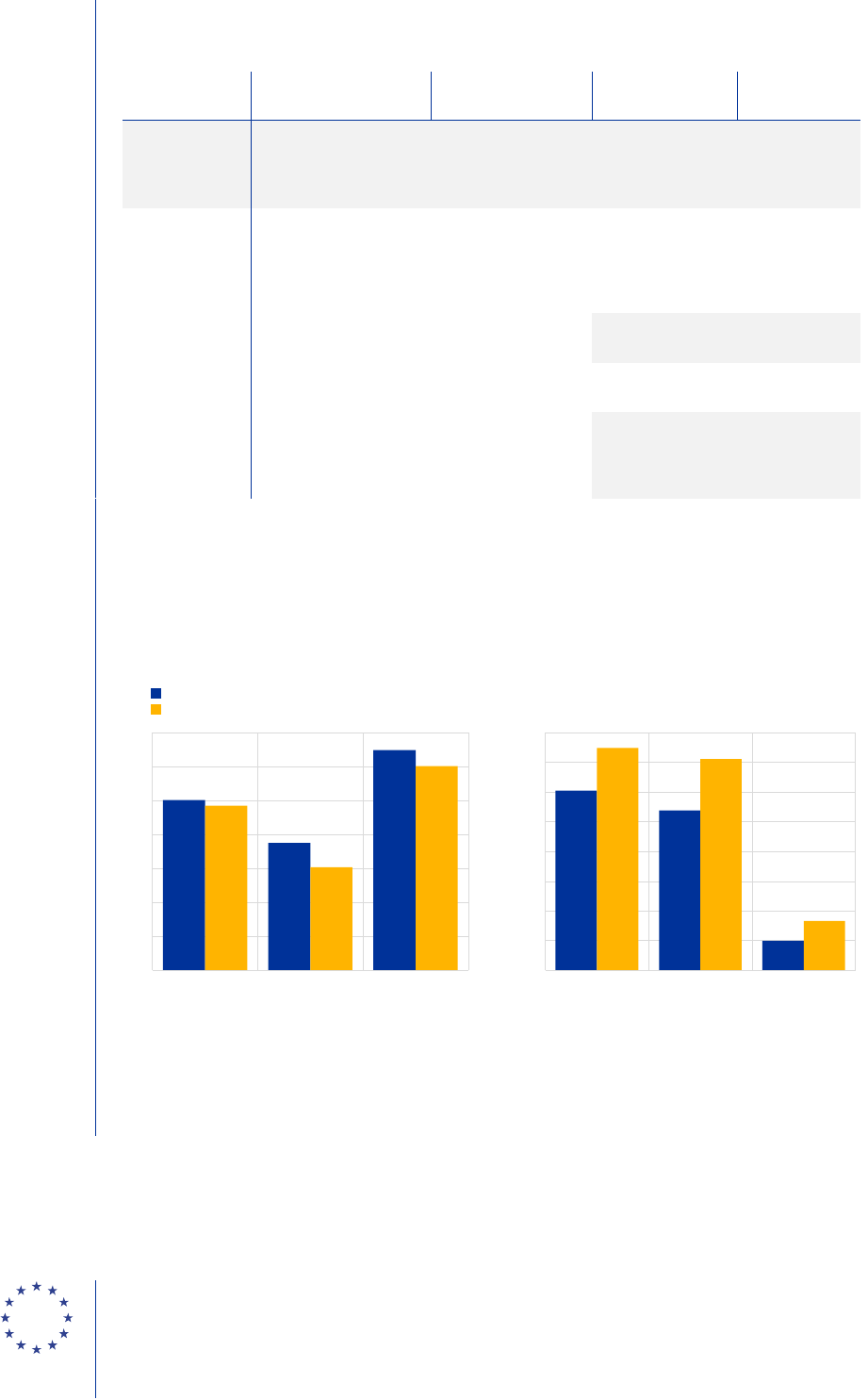
Liquidity risks arising from margin calls / June 2020
Annex A: Background charts
24
Table A.5b
Liquidity and funding requirements for derivatives
Framework Definition
Numerator for
derivatives
Denominator for
derivatives
Legal references
and notes
LCR
Unencumbered liquid assets
/ (Stressed outflows –
inflows)
Posted margins
decreases stock of
available unencumbered
assets
No effect, If
collateralized by high
quality liquid assets.
CRR Art. 412,
415-425
NSFR
Available stable
funding/Required stable
funding
0%
100% of derivative
assets net of VM
received minus
derivative liabilities (if
positive)
Basel III: the net
stable funding
ratio, Table 1 and
Table 2
+ 20% of derivative
liabilities (gross of VM)
In EU applicable
since June 2021
85% of initial margins
posted and
contributions to default
funds of CCPs
Sources: European Systemic Risk Board, EBA Interactive single rulebook, BIS (2019a-e).
Note: Treatment might differ depending on specific circumstances.
Chart A.3
Liquid asset holdings of euro area non-bank financial institutions
(left panel: percentage of highly liquid securities in total securities holdings; right panel: EUR billions)
Sources: ECB Securities Holdings Statistics and ECB calculations.
Notes: Highly liquid securities are classified according to the Basel Liquidity Coverage Ratio requirements for high-quality liquid
assets. Liquid bonds comprise Level 1 euro-denominated bonds issued by European governments and non-euro-denominated
government bonds rated at least AA.
0
200
400
600
800
1 000
1 200
1 400
1 600
Insurance
corporations
Investment funds Pension funds
Billions
0%
10%
20%
30%
40%
50%
60%
70%
Insurance
corporations
Investment funds Pension funds
2013
2019
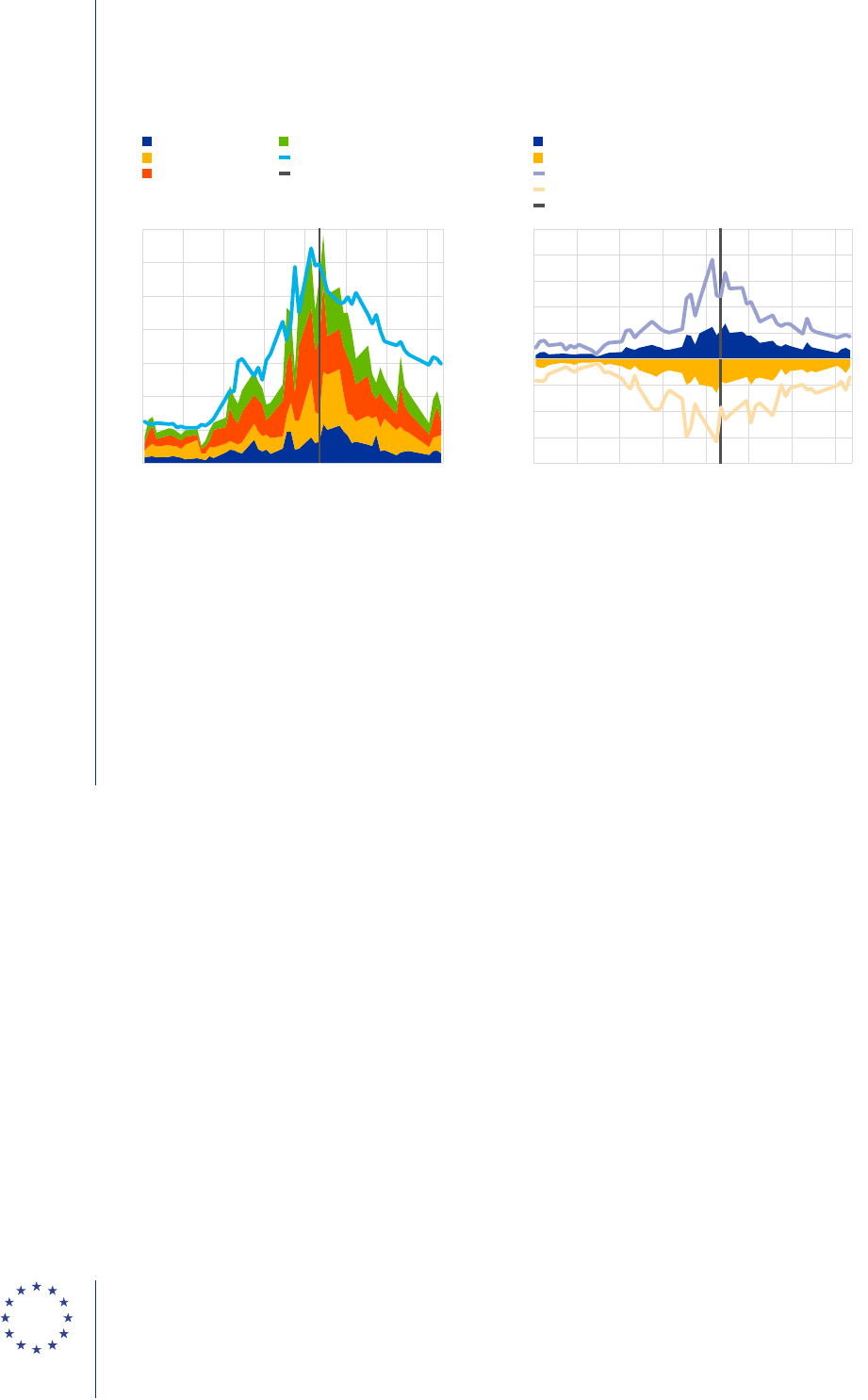
Liquidity risks arising from margin calls / June 2020
Annex A: Background charts
25
Chart A.4
The size and composition of variation margin calls on funds’ derivative portfolios during the
coronavirus market turmoil
(left panel: left-hand scale: EUR billions; right-hand scale: percentage points; right panel: EUR billions)
Sources: Fache Rousová, L., Gravanis, M., Jukonis, A. and Letizia, E. (2020), “Derivatives-related liquidity risk facing
investment funds”, European Central Bank Financial Stability Review, Special Feature B, May 2020, Chart B.2, as based on
EMIR data, sector classification from Lenoci and Letizia (2020), Bloomberg and authors’ calculations.
Notes: Left panel: calculated as the sum of all positive margin calls on euro area investment funds, where a positive margin call
occurs if either variation margin posted increases or variation margin received decreases from one day to another. The
classification of derivative portfolios into asset classes is based on notional amounts using an 80% threshold: if more than 80%
of the notional value of contracts in the portfolio belongs to one asset class, the portfolio is classified in this asset class. Right
panel: estimates are computed by rescaling the variation margin calls proportionally to the notional amount that they represent
for a specific asset class, in order to take into account the fact that some trades are reported as collateralised by variation
margin (in the field ‘collateralisation’ in EMIR reporting), but the size of the margin (in the fields ‘variation margins posted’ and
‘variation margin received’) is either not reported at all or not updated on a daily basis. PEPP stands for pandemic emergency
purchase programme. The latest observation is for 17 April 2020.
-40
-30
-20
-10
0
10
20
30
40
50
04/02 14/02 24/02 05/03 15/03 25/03 04/04 14/04
Daily variation margin calls – reported
Daily variation margin received – reported
Daily variation margin calls – full sample estimate
Daily variation margin received – full sample estimate
PEPP announced
0
10
20
30
40
50
60
70
80
90
0
2
4
6
8
10
12
14
04/02 14/02 24/02 05/03 15/03 25/03 04/04 14/04
Interest rate
Currency
Equity
Other
VIX (right-hand scale)
PEPP announced
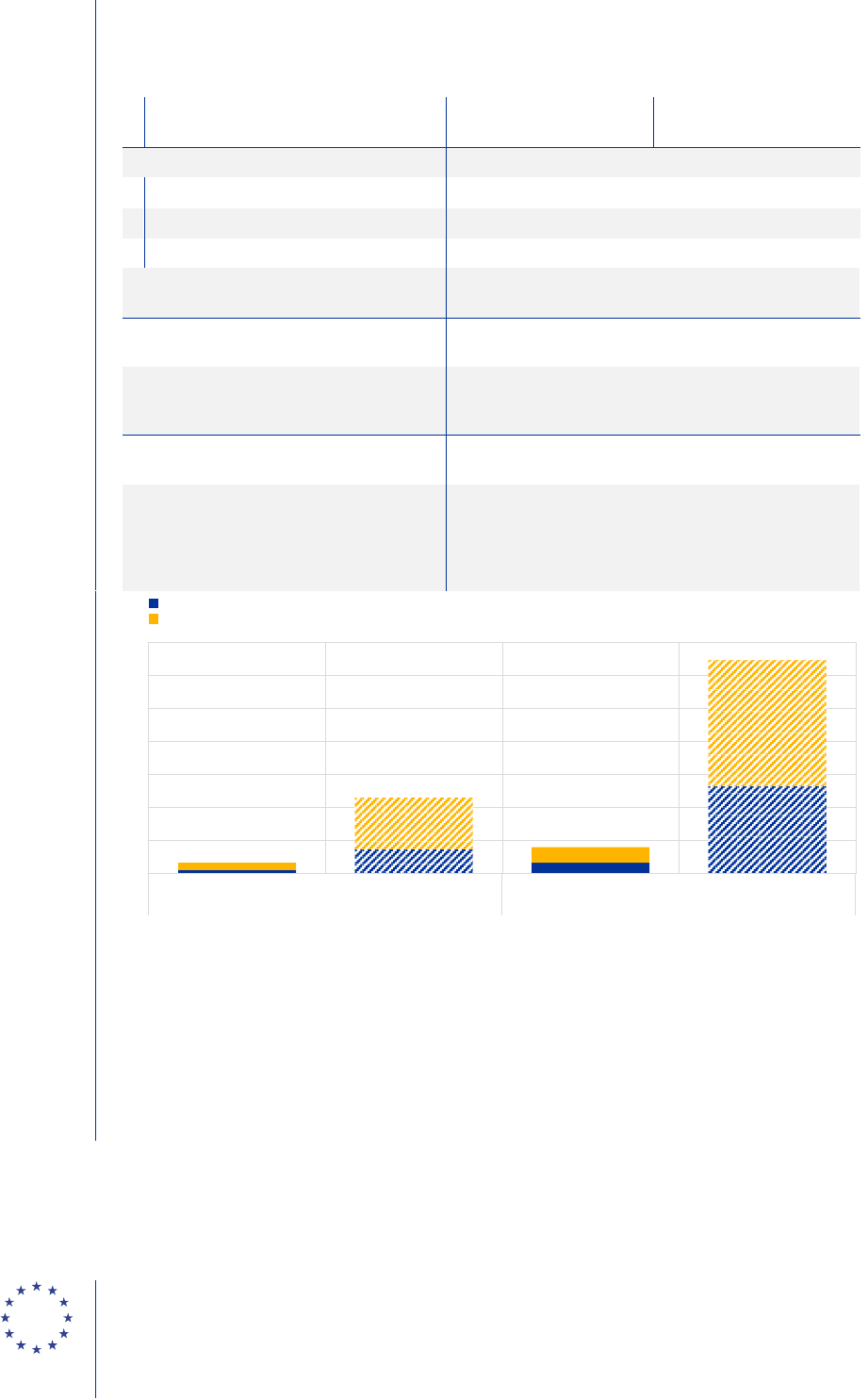
Liquidity risks arising from margin calls / June 2020
Annex A: Background charts
26
Chart A.5
Margin calls, liquidity shortfalls and share of funds with shortfalls under two stress
scenarios
Scenario 1:
Extreme one-day movement
Scenario 2:
Prolonged market turmoil
Shocks on:
interest rate curves -25bps parallel shift -75bps parallel shift
USD-EUR exchange rate 2% USD depreciation 5% USD depreciation
major equity indices 5% decline 15% decline
Rationale
Shocks similar to extreme market movements observed during
September and October 2008 and March 2020
Liquidity buffer
Cash
Cash and high-quality
government bonds
Rationale
Daily variation markgins are typically required only in cash and there
could be limited possibilities for collateral transformation under
scenario 1
Netting of collateral in- and out-flows among
derivative portfolios
No Yes
Rationale
Netting of collateral inflows and outflows among derive portfolios
may not be possible under scenario 1 because the timing of
collateral in- and outflows may not coincide under scenario 1.
Instead, collateral inflows and outflows can offset each other under
scenario 2
Sources: Fache Rousová, L., Gravanis, M., Jukonis, A. and Letizia, E. (2020), “Derivatives-related liquidity risk facing
investment funds”, European Central Bank Financial Stability Review, Special Feature B, May 2020, Chart B.3, as based on
EMIR data, sector classification from Lenoci and Letizia (2020), Refinitiv and authors’ calculations.
Notes: Based on data at the end of 2018. Sample with cash and liquidity buffers includes 3,523 funds, for which liquidity buffers
are available. The full sample includes 13,969 funds, for which EMIR data indicate a holding of a derivative portfolio and
variation margin can be calculated. The rescaling to the full sample assumes that the ratio of the cash shortfall to the size of the
variation margin call is the same in the two samples. It is assumed that all derivative holdings are collateralised by variation
margin.
0
20
40
60
80
100
120
140
Sample with cash buffer Full sample estimate Sample with liq. buffer Full sample estimate
One-day movement Prolonged market turmoil
Margin call covered by buffer
Shortfall from margin call
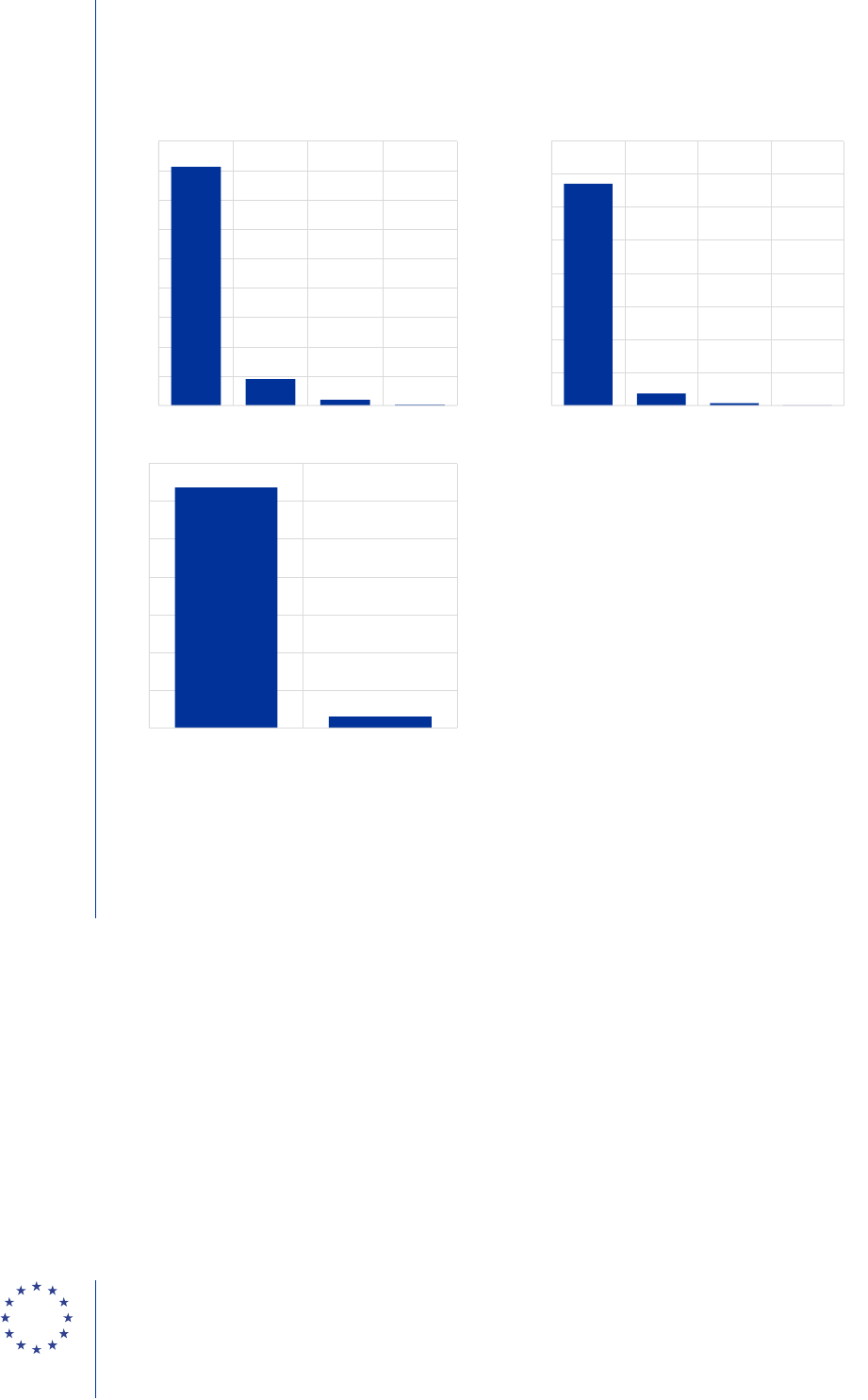
Liquidity risks arising from margin calls / June 2020
Annex A: Background charts
27
Chart A.6
Number of dealers per client in derivatives markets
(x-axis: number of dealers; y-axis: frequency)
Sources: European Systemic Risk Board, EMIR data and ESRB Secretariat calculations.
Notes: Data are as of May 2019. See El-Omari, Y., Fiedor, P., Lapschies, S., Schaanning, E., Seidel, M. and Vacirca, F. (2020),
“Interdependencies in central clearing in the EU derivatives market”, European Systemic Risk Board Occasional Paper,
forthcoming. The upper panel shows that approximatively 8,000 clients are using a single dealer to clear interest rate derivatives
(albeit this may involve different dealers for different clients), while about 1,000 use two dealers and a negligible fraction of
clients use more than three dealers to clear their interest rate derivatives.
0
1,000
2,000
3,000
4,000
5,000
6,000
7,000
8,000
9,000
1 2 3-4 5+
a) Interest rate derivatives
0
2,000
4,000
6,000
8,000
10,000
12,000
14,000
16,000
1 2 3-4 5-10
b) Equity derivatives
0
50
100
150
200
250
300
350
1 2-4
c) Credit derivatives
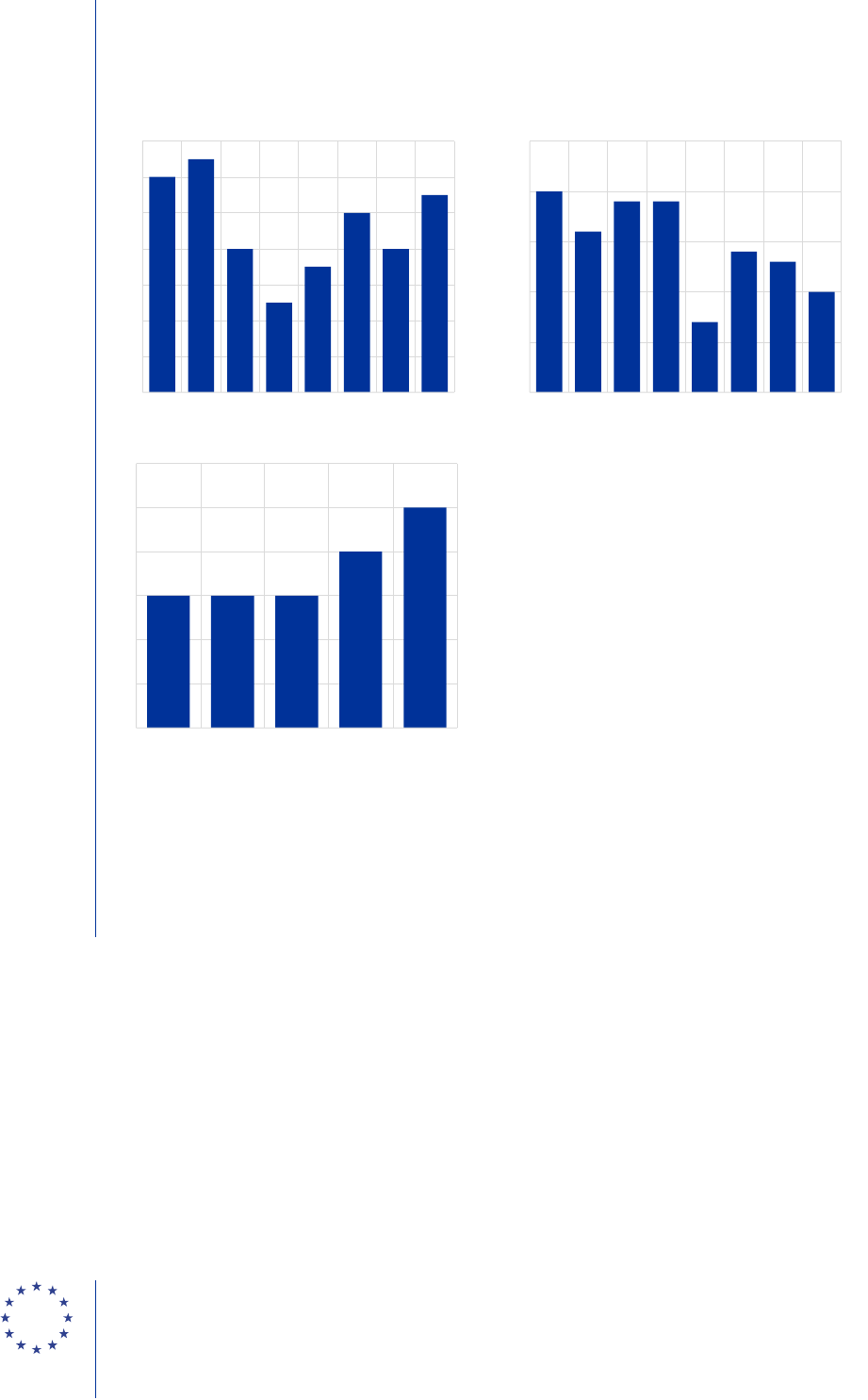
Liquidity risks arising from margin calls / June 2020
Annex A: Background charts
28
Chart A.7
Number of clients per dealer in derivatives markets
(x-axis: number of clients; y-axis: frequency)
Sources: European Systemic Risk Board, EMIR data and ESRB Secretariat calculations.
Notes: Data are as of May 2019. See El-Omari, Y., Fiedor, P., Lapschies, S., Schaanning, E., Seidel, M. and Vacirca, F. (2020),
“Interdependencies in central clearing in the EU derivatives market”, European Systemic Risk Board Occasional Paper,
forthcoming. The upper panel shows, for instance, that there are 11 clearing members that have more than 300 clients for whom
they clear interest rate derivatives. Another 8 dealers are clearing members for between 201 and 300 clients, while 10 dealers
clear for between 101-200 clients. About 25 dealers also clear for only 1-10 clients. The ranges are established for data
confidentiality reasons.
0
2
4
6
8
10
12
14
1-2 3-10 11-20 21-50 51-
100
101-
200
201-
300
300+
a) Number of clients per dealer – interest rate
0
5
10
15
20
25
1-2 3-5 5-10 11-50 51-
100
101-
200
201-
500
501+
b) Number of clients per dealer – equity
0
1
2
3
4
5
6
1 2-3 5-10 11-20 21+
c) Number of clients per dealer – credit
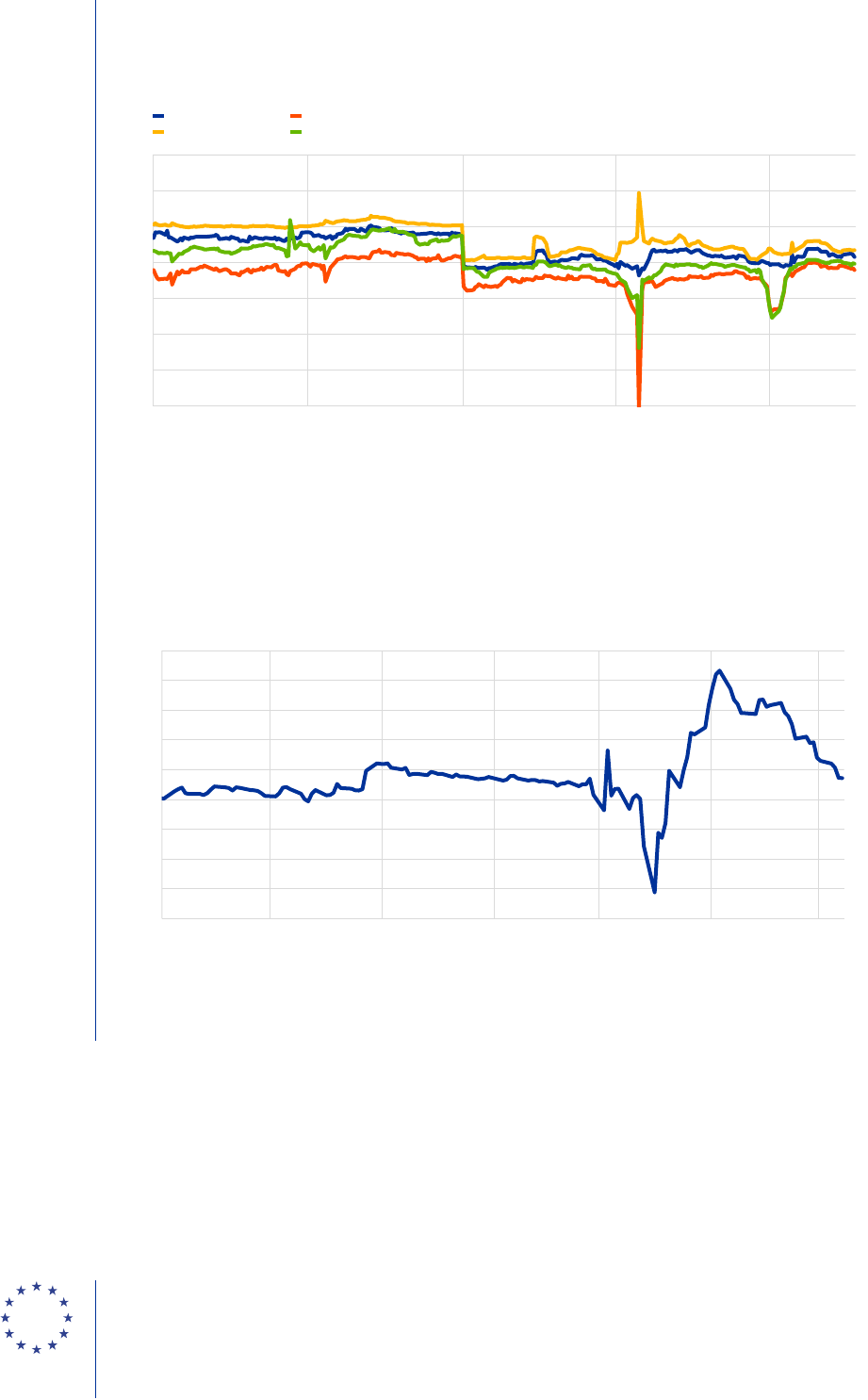
Liquidity risks arising from margin calls / June 2020
Annex A: Background charts
29
Chart A.8
Repo funds rate
(percentage per annum)
Source: Repo Funds Rate.
Note: The latest observation is for 7 May 2020.
Chart A.9
Cross-currency basis swap between USD and EUR
(basis points)
Source: Bloomberg.
Note: The latest observation is for 7 May 2020.
-0.9
-0.8
-0.7
-0.6
-0.5
-0.4
-0.3
-0.2
03/19 06/19 09/19 12/19 03/20
RFR Spain
RFR Italy
RFR Germany
RFR France
-100
-80
-60
-40
-20
0
20
40
60
80
11/19 12/19 01/20
02/20 03/20
04/20
05/20

Liquidity risks arising from margin calls / June 2020
Annex B: Background information
30
B.1: Margining types and factors behind margin developments
Variation margins (VM): Positions are marked-to-market and changes in valuations due to price
moves are exchanged on a daily basis in the form of variation margin between CCPs and other
counterparties. Higher market volatility leads mechanically to higher VM flows.
Initial margins (IM): CCPs collect collateral to cover potential future losses on a defaulting
participant’s portfolio over the period where they manage the default and reallocate the portfolio to
surviving participants (other counterparties also do so for bilateral OTC derivatives).
Intraday margin calls (IDMC): CCPs collect margins intraday, either on a business-as-usual basis
or specifically in high volatility conditions. Such margin calls cover both mark-to-market changes
(VM) and potential future losses (increases in IM). Increases in IDMCs were also observed over the
recent period of market stress.
Potential future losses have increased sharply due to the higher volatility since the outbreak
of the COVID-19 pandemic. As a result, initial margins increased sharply in some market
segments. This was most visible in equity and commodity markets, where volatility has been
particularly high.
17
Credit derivative markets have also seen large increases in initial margin
requirements.
18
In other markets, such as interest rate derivatives, margin increases have been
smaller due to less acute increases in volatility. There is evidence that some markets, in particular
equities, experienced significantly higher trading volumes. The increase in the size of positions was
one important factor in the increase in initial margin requirements. However, the main driver of the
increase in initial margins was the response of margin models to increased volatility and tail risks. A
number of CCPs have also increased initial margin parameters, in particular on equity instruments,
which also led to higher initial margins.
B.2: Developments in repo markets
Until now, European money market statistical reporting (MMSR) data reported by the
50 largest banks suggests that the European repo market has remained remarkably stable
during the COVID-19 crisis. Transaction volumes did not contract much, although the end-of-
quarter effect in March was slightly more pronounced. However, trading volumes with investment
funds, the second largest counterparty sector after banks, decreased quite sharply at the end of
March. As volumes recovered again – to some extent – this pattern was at least partly driven by an
end-of-quarter effect. After a temporary decrease in repo interest rates, possibly due to the ECB
17
In respect of commodities, this may be due to factors other than the COVID-19 crisis, in particular oil production decisions
and the resulting volatility.
18
In the case of credit default swaps (CDS), a part of the margin model calculation is proportional to the level of the spread.
Since spreads increased massively and remained at a higher level, this contributed to the sustained increase in initial
margin for these asset classes.
Annex B: Background information

Liquidity risks arising from margin calls / June 2020
Annex B: Background information
31
intervention, rates are back to their normal levels (see also Chart A.8 in Annex A). In the bilateral
market, the proportion of repos carrying zero, negative and positive haircuts has stayed broadly
constant.
19
However, the absolute value of non-zero haircuts is becoming slightly larger (larger
positive and negative haircuts, respectively), which may indicate that market participants are
becoming slightly more risk-conscious.
While the repo market appears to be quite stable, a number of vulnerabilities are still
present. While the bulk of the transactions are cleared by CCPs, as measured by the stock
of outstanding repos, the bilateral repo market is very significant. As argued in the recent
ESRB report
20
, an increase in risk-aversion towards counterparty credit risk could result in lower
capacity or even a breakdown in this market segment. Furthermore, a significant proportion of
bilateral repos are backed by bonds issued by banks and financial institutions. Finally, there is a
tendency for banks to use collateral issued in their own country.
B.3: Concentration and client clearing
The concentration of clearing services among a few CCPs and clearing members is a well-
known issue, already clearly identified by a number of analyses carried out both at
international and European level.
21
At the global level, for some asset classes most of the
exposure in the market is concentrated among a handful of major CCPs
22
and a small number of
G-SIBS are the top clearing members in the largest CCPs. At the European level, the situation is
similar
23
even though the level of concentration seems lower; the 2018 ESMA report on the second
CCP stress test exercise shows that the top clearing member groups have simultaneous exposures
to multiple European CCPs even though “… keeping in mind the limitations of the exercise, the
interconnectedness analysis has indicated that these exposures would generally not hit
simultaneously the default fund waterfall of all these CCPs under one of the common, internally
consistent stress scenarios considered.” With regard to concentration, the analysis of the level of
concentration at individual clearing participants, assessed using the Herfindahl-Hirschmann Index
(HHI) methodology and thresholds, has not shown systemically critical concentrations at single
clearing members or groups at EU-wide level.
Current client clearing arrangements can be characterised as follows: i) they are mostly
based on Futures Industry Association documentation, but typically entail bespoke elements;
ii) initial margin requirements are typically set using internal models of the clearing member, with
CCP margin requirements as a floor; iii) counterparty-specific add-ons to those initial margin
requirements can be quite high (up to 50%); iv) collateral schedules themselves are rather strict –
typically only collateral accepted at CCPs is eligible, however, the repo desks of clearing providers
19
Under the MMSR haircuts in the CCP-cleared segment are not reported.
20
European Systemic Risk Board (2020a), Mitigating the procyclicality of margins and haircuts in derivatives markets
and securities financing transactions, January 2020.
21
Such analyses have been carried out at the international level by the Financial Stability Board (FSB) and Standard-Setting
Bodies (SSBs) and at the European level by the European Securities Markets Association (ESMA) and the ESRB.
22
For example, The SWAPClear service of LCH Ltd handles approximately 80% of the amount of cleared interest rate swaps;
similarly, the ICE CCPs (US and Europe) clear the majority of CDS, both on indexes and single names.
23
See ESMA’s EU-wide CCP Stress Test 2017.

Liquidity risks arising from margin calls / June 2020
Annex B: Background information
32
typically offer (but are not contractually obliged to provide) collateral transformation services to their
clients; v) clearing providers typically have the contractual right to call for variation margin intraday,
but will normally refrain from doing so and usually pre-fund variation margins that the CCP calls
intraday; vi) the clearing member generally has the right to terminate the client clearing contract at
short notice (typically, 1-3 months, which could be longer than it would take for clients to negotiate
new contracts).
Concentration at CCPs and clearing members, combined with interconnectedness among
CCPs through common clearing members, liquidity providers, custodians or investment
counterparts, may also give rise to further cascade effects. The concentration of clearing
services at a few CCPs and in a few clearing members active in several markets is a well-known
issue, already clearly identified by a number of analyses carried out both at the international and at
the European levels, as well as being documented in this report (see Tables A.1-A.3 and Figure A.2
in Annex A). The implications of a default increase with concentration and interconnectedness.
Concentration at a CCP means that any material margin calls, non-pass-through of intraday
variation margins, changes in haircuts, etc. would affect several major entities at the same time – or
even the whole financial system. Likewise, concentration at clearing provider level means that
material changes in client clearing conditions would affect many clients at the same time, possibly
amplifying liquidity stress at the level of the market. However, the current framework for CCPs’
liquidity stress testing only accounts for interconnectedness to a very limited extent, as there is no
requirement to address concerns related to the concentration in the provision of different services
to or by the CCPs. For example, a bank can be a clearing member at one CCP, but also at the
same time play an important role at another CCP by providing liquidity to that CCP. Currently,
liquidity stress tests of CCPs only partially account for such liquidity providing service relationships.
B.4: The impact on non-bank financial entities and non-financial
corporations
Non-banks can be vulnerable to liquidity risks stemming from margin calls. Non-bank
financial intermediaries and non-financial corporations (in the following grouped together as “non-
banks”) can have sizeable derivatives exposures. Because of this, as shown in simulations
referenced in the recent ESRB report
24
, non-banks such as some investment funds, pension funds
and insurance companies could face potentially large margin calls. Since they do not have access
to central bank refinancing operations, non-banks that choose to hold low cash buffers and low
amounts of high quality collateral – which is typically accepted for margin calls – have to rely on
funding and collateral transformation services provided by large banks and broker-dealers and may
otherwise be forced to close positions.
Non-banks are particularly exposed to margin calls from counterparties in bilateral
derivatives markets and from their client clearing provider. Non-banks typically use bilaterally
cleared derivatives and/or access CCP-cleared derivative markets through a client clearing
24
European Systemic Risk Board (2020a), Mitigating the procyclicality of margins and haircuts in derivatives markets
and securities financing transactions, January 2020.

Liquidity risks arising from margin calls / June 2020
Annex B: Background information
33
provider. Most non-banks thereby rely on the services of only one client clearing provider and do
not have backup arrangements in place.
To date, there is little precise information available for assessing the severity of margin calls
faced by non-banks during the crisis period since February 2020. Anecdotal evidence points to
increasing margin calls also for non-banks such as funds, but most “severe” cases reported were
linked to the United States rather than Europe.
25
On the funding side, MMSR transaction data show
a large decrease in repo funding extended by EU banks to investment funds in March 2020, in
particular to funds domiciled in tax havens such as the Cayman Islands. However, the drivers of the
latter development are not clear at this point in time.
Going forward, non-banks could be particularly vulnerable in the event that client clearing
providers impose less favourable conditions on them. If volatility in financial market segments
picks up again, a situation might arise where client clearing providers impose less favourable
conditions on clients. This could be prompted, for example, by less “comfortable” liquidity conditions
at clearing providers. Such less favourable conditions might include: i) increased intraday margin
calls to clients; ii) restricted funding of clients by repo desks; iii) higher total initial margin
requirements, e.g. because of add-ons. Clearing providers might even be tempted to terminate
client clearing contracts.
B.5: Examples of developments in bilaterally cleared markets
During recent weeks, there have also been some issues caused by margin calls in foreign
currency swaps that were cleared bilaterally.
26
For example, in Norway this caused the banks’
funding situation to deteriorate during the most turbulent days in March. Fund managers, insurance
and pension funds hedge the NOK value of their foreign investments. When the NOK depreciated,
they had to pay margin calls to their counterparties in currency swap agreements. They mostly sold
liquid securities denominated in NOK to meet the margin calls, which led to a fall in the price of
Norwegian bonds. The sale of bonds by fund managers to meet margin calls amplified the sharp
fall in the prices of banks' bonds and worsened the financing market. Fund managers also reduced
their currency hedges due to falling asset prices on foreign investments. This resulted in a further
weakening of the NOK and in turn increased margin calls. The significant effect this had on banks
and financial markets was due to the NOK weakening more than many other currencies and
Norwegian fund managers having a large proportion of their foreign investment hedged in foreign
currency. Banks’ liquidity was not directly affected by the significant weakening of the NOK, since
their foreign currency debt is hedged by currency swaps.
25
According to US newspaper reports, it seems to be mainly Real Estate Investment Trusts (REITs) that have been affected
by margin calls. Noteworthy developments in Europe include: UBS as one of the world’s largest wealth managers reporting
that investors are adjusting their portfolios in order to meet margin calls and ABN Amro confirming that it will incur a
USD 200 million loss after a single client failed to meet margin calls.
26
See also an example of pricing developments in currency swaps in Chart A.9 in Annex A.

Liquidity risks arising from margin calls / June 2020
Annex B: Background information
34
B.6: Future risks including new channels
Possible channels of liquidity strain include measures taken by CCPs to mitigate credit risk
stemming from collateral issuers or clearing members. So far, there is only anecdotal evidence
that some CCPs have moderately increased haircuts on certain types of collateral. CCPs have not
restricted collateral eligibility criteria or reduced issuer concentration limits. However, the crisis
effect on collateral may materialise in the future, e.g. if government bonds or other bonds that are
currently accepted as collateral were downgraded. CCPs may adjust their government and
corporate bond haircuts or eligibility criteria in line with these developments. If such measures were
taken in the future, clearing members would have to provide additional collateral or – in extreme
scenarios, if some government bonds are excluded from the pool of eligible collateral – this could
lead to clearing members having to substitute large amounts of collateral at short notice.
Furthermore, there is so far no sign that CCPs are downgrading their internal credit assessment of
their clearing members, a move which could in turn lead to additional margin calls (credit risk add-
ons) on less resilient members. These measures are, however, more likely to become common in
future weeks and months, as the implications of the macroeconomic context for counterparty credit
risk become more evident.
It is reasonable to expect concentration and interconnectedness to increase in the short and
medium term. Given the high fixed costs involved in providing clearing services and the low
profitability of this line of business the number of institutions offering client clearing services might
be expected to decrease over time. Anecdotal evidence already suggests that in previous years an
increase in concentration has been observed following the exit of certain client clearing service
providers.
At the current juncture, it is unclear whether the current stressed circumstances have
further increased the concentration among CCPs/clearing members or interconnectedness.
From the preliminary market intelligence carried out so far, no apparent major and new pinch point
has emerged yet for the provision of clearing services; nor has any major player announced their
intention to withdraw from this line of business.
As the Financial Stability Board (FSB) report of November 2018 has shown, the provision of
client clearing services is usually carried out by clearing members as part of a package of
services. Reportedly, such services when provided on a stand-alone basis do not offer an
adequate return on the necessary investments. However, this trend does not seem specific only to
central clearing services; it is common also to other post-trading services, such as custodial
services which, likewise, entail significant fixed costs.
From this perspective, it can be assumed that the current risks linked to the increasing
concentration and interconnectedness will remain, possibly increasing as the crisis evolves.
Overall, the most significant risks linked to concentration and interconnectedness are related to
likely cascade effects in the event of a major default. Such risks are likely to remain or even
increase as the volatile market developments prevail.

Liquidity risks arising from margin calls / June 2020
Annex B: Background information
35
B.7: Monitoring needs
As regards increases in margin levels, there is still a need for more granular evidence, most
importantly to assess the performance of IM models in terms of procyclicality. The ESRB
Expert Group on Margins and Haircuts should assess key aspects of this. First, they should
analyse whether the changes in initial margins are significant or not when compared to variation
margin flows. Second, they should examine whether initial margin models have responded as
expected to the recent volatility episodes, or whether they have overshot and/or whether embedded
anti-procyclicality has sufficiently mitigated initial margin increases. Another aspect of this
monitoring is to further examine which types of financial instruments and market participants have
been most affected by the crisis, in order to further tailor the ESRB’s policy response.
Monitoring will also need to turn to potential problems resulting from collateral haircuts,
eligibility or issuer caps, and from credit risk add-ons set by CCPs. As there is a greater than
normal chance of these effects materialising in the weeks and months to come, the ESRB should
conduct a fact-finding exercise to monitor whether mitigating measures taken by CCPs lead to
temporary liquidity strains or difficulties in sourcing collateral, or to a widespread procyclical
increase in margin levels due to credit risk add-ons.
At the microprudential level, the regulatory framework requires CCPs to play an active role
in containing the potential consequences of a concentration of exposures. With regard to
clearing members, CCPs are not mandated to impose concentration add-ons but are required to
monitor the size of exposures vis-à-vis the depth and liquidity of the relevant market and consider
applying such add-ons when appropriate. Moreover, CCPs are required to avoid excessive
concentration at certain intermediaries for the provision of investment services or liquidity facilities.
CCP supervisors are expected to closely monitor that CCPs have a proactive approach to limit
concentration at certain intermediaries.

Workstream members
Emmanuelle Assouan
Chair, Banque de France
Benjamin Schiessle
European Securities and Markets Authority
Thomas Droll
Deutsche Bundesbank and ESRB Margins & Haircuts
Task Force
Pietro Stecconi
Banca d’Italia and ESRB CCP Task Force
Zénó Fülöp
Magyar Nemzeti Bank
Fiona van Echelpoel
European Central Bank
Loriana Pelizzon
Advisory Scientific Committee
Magdalena Grothe
Secretary, European Systemic Risk Board Secretariat
Martin Scheicher
European Central Bank /Single Supervisory
Mechanism
This report has also benefited from contributions and inputs by:
A. Ciullo, J. Denijs, M. Dvořák, M. D'Errico, S. de Quant, G. Insalaco, E. Katsigianni, E. Karfis, P. Marques,
E. Schaanning, C. Schett, C. Übelhör, O. Weeken (all European Systemic Risk Board Secretariat), C. Di Luigi,
O. Panzarino (both Banca d’Italia) and T. Carre, M. Gex (both Banque de France), D. Krause, M. Schmidt,
M. Seidel, B. Stahlhofen (all Deutsche Bundesbank), L. Fache Rousová, M. Gravanis, S. Kördel, P. Marmara,
C. Rouveyrol, F. Vacirca (all European Central Bank), M. de Giovanni (European Central Bank/Single
Supervisory Mechanism), Y. El Omari (European Securities and Markets Authority), M. Erard (Norges Bank).
This report gratefully acknowledges the comments by the members of:
ESRB General Board, ESRB Steering Committee, ESRB Advisory Technical Committee and ESRB Advisory
Scientific Committee
Imprint and acknowledgements
© European Systemic Risk Board, 2020
Postal address 60640 Frankfurt am Main, Germany
Telephone +49 69 1344 0
Website www.esrb.europa.eu
All rights reserved. Reproduction for educational and non-commercial purposes is permitted provided that the
source is acknowledged.
The cut-off date for the data included in this report was 15 May 2020.
For specific terminology please refer to the ESRB glossary (available in English only).
ISBN 978-92-9472-144-0 (pdf)
DOI 10.2849/22615 (pdf)
EU catalogue No DT-01-20-343-EN-N (pdf)

